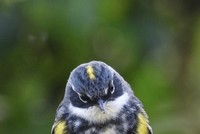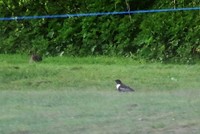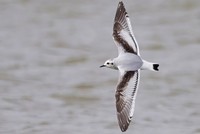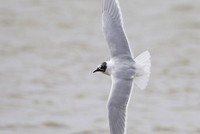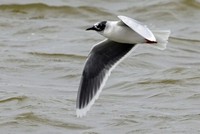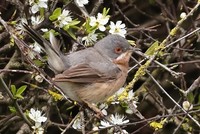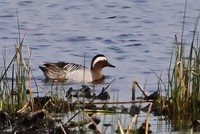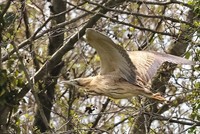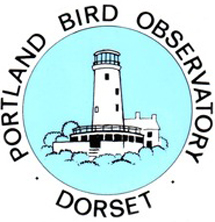Weekly round-up: 01 - 07 October 2014
That’s a role call and a half isn’t it…?
The week that just couldn’t stop giving…
A pretty classic mix of outrageously good looking, very rare birds scattered not only on far-flung isles but also, in a couple of cases, in easily accessible locations and (as is so often the way now), “available” across a weekend too.
The weather did exactly as was mentioned at the end of last week’s roundup ~ the warmth finally slipped away as a hefty Atlatic weather system bounded our way. The mish-mash of (down south) warm southeasterlies suggested that birds from eastern deserts were surely on the agenda whilst the strong southeasteries blowing in to Shetland and Orkney surely had to yield far eastern forest goodies.
As the high was blown away by the strong west or northwest winds, expectations soared that it would be birds from the Nearctic that would push their way through to the forefront of everyone’s minds.
Yes, this week, opretty much every scenario was called right.
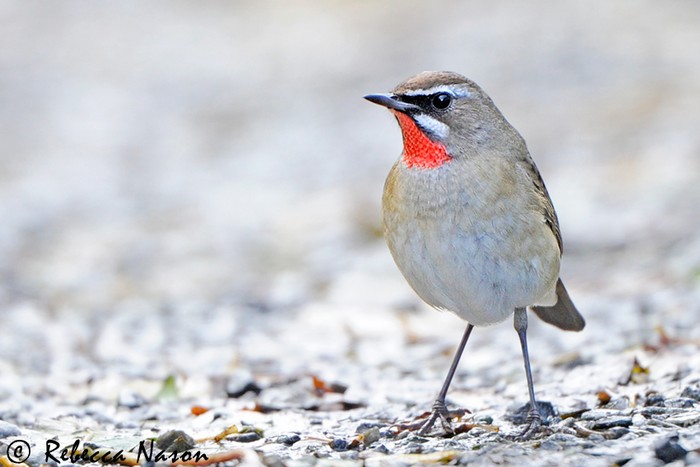
Whilst sitting in the sterile, “bright-light, bright-light” environs that make up the “Match of the Day” VT area, waiting to rehearse with a new bit of kit ahead of Sunday’s show, my idle mind began wandering and thinking of just how nice and quiet things were birdwise ~ despite it being only Friday afternoon, despite it being ahead of the, now-familiar, pattern of the weekend “mega” appearing as birders get in to the field, despite the potentially rare inducing weather apparently not getting itself fully in to gear ~ yes, from a totally selfish point of view, it was so nice and quiet (give or take another mini-wave of Yellow-browed Warblers ), the review that lay ahead my not be quite as long and as mad as recent weeks….
And then the Mega Alert went off.
And there were very few surprises in the message that followed.
Location. Shetland. Quel surprise
…and on Mainland too. Where else?!?
Species. Siberian Rubythroat. What else?!?!
Sex. Male. But of course…
Age. Adult. A first for Britain! Holy cow…!
Species aside, a monster “Sibe” was on the cards ~ buried amongst the multiple 1000’s of words of waffle, general BOURC bashing (fear not, BBRC’s turn will come soon, as soon as there’s a fly-by Brunnich’s Guillemot somewhere…) the following was laid forth by way of informed musing near the end of last week’s offering…
”…the Northern Isles would seem to be the place to keep an eye on while the weather shifts around ~ the gloves are off right now and any “Sibe” could smash their way in to our consciousness.”
And so it did, with the dazzling afternoon discovery at the north end of Levenwick on the Shetland mainland, just before the clock tick-tocked itself towards 4pm on 3rd ~ becoming our earliest ever record in the process.
Yet another Rubythroat for Shetland, this bird capped off a stellar week for the largest island in the archipelago, where both Myrtle Warbler and White’s Thrush have already shown themselves within the calendar week. That is some trio, a powerhouse birding equivalent of The Jimi Hendrix Experience, Cream or Neil Young & the Restless and this stunner was, quite obviously, the cherry-throated icing on a very big Rare Cake indeed (try and get Mary Berry to bake one of those muthas…).
The WOW! Factor, the F*ck Me Factor (if you will pardon the swerve towards the Anglo-Saxon vernacular) remains as high as ever where this magnificent species, this marvellous, oft-dreamt of Far Eastern traveller but, thanks to Mainland Shetland’s most recent cut-throat gem, this is a species that has been (whisper it) ever-so-slightly devalued of late.
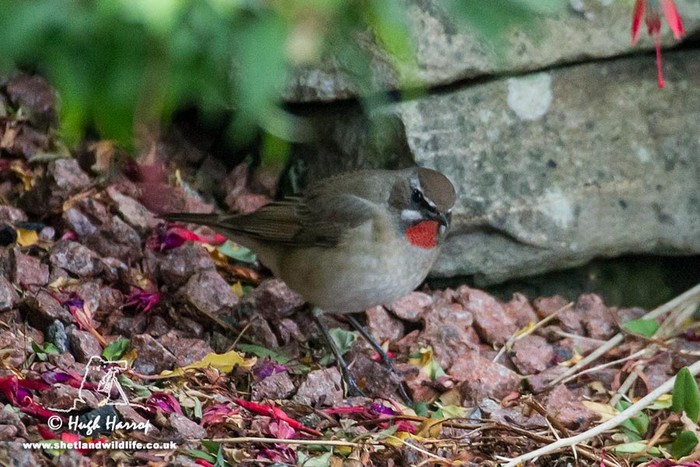
Siberian Rubythroat is getting commoner, an indisputable fact but (major drawback coming…) Shetland remains the only place go. There will be another East coast bird but for the moment, as you’d expect, Shetland reigns supreme ~ nine of the (now) eleven British records appearing there over the past almost four decades, since the first was found on Fair Isle on October 9th 1975.
A huge gap followed until the second, the remarkable, much debated, discussed and doubted (in terms of where it came from) male at Osmington Mills in Dorset on October 19th 1997. Shetland’s second (and Britain’s third) a freshly dead male, was found as a roadside casualty near Bixter, on the Shetland Mainland on October 25th 2001 before Fair Isle’s second, a three-day first-winter female was seen in October 2003.
The past decade has seen seven more arrive ~ a very good average that ~ (nine since the turn of the 2000’s) with Fair Isle collecting another first-winter female between October 23rd-27th 2005, to be followed by the east coast’s sole representative, the suppressed first-winter female in a garden in Sunderland late in October 2006.
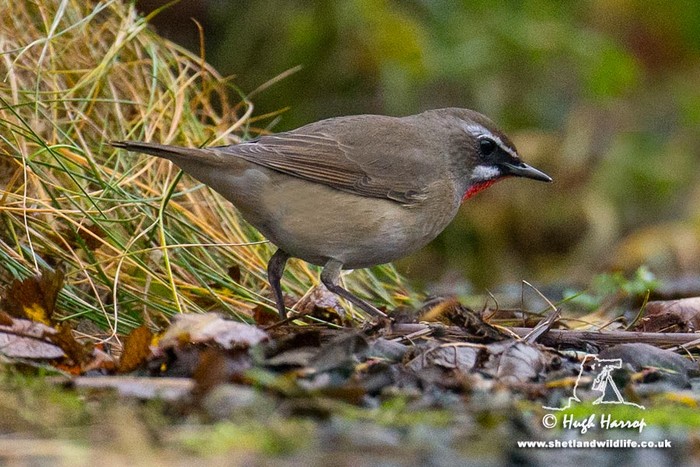
Shetland’s next bird, a stunning male, peeked out of the Foula iris beds on October 5th 2007 and, four October’s later came that monster male in Gulberwick gardens, the first one to linger in to double figure days ~ present from October 18th-30th 2011 and well twitched by many.
Perhaps unsurprisingly, the female the following year on Fair Isle (that particular island’s fourth Rubythroat and the second to linger beyond the 10-day mark ~ this one managing 12, between October 23rd to November 3rd 2012) didn’t draw the crowd it might have done and neither did the male found on Fair Isle in the third week of last October.
A mainland bird does feel overdue and it always feels as though Flamborough, Spurn, maybe Wells Woods, or Gibraltar Point or even Landguard could be the place that enables 100’s to get a crack at one without the extreme expense of Shetland. That day is a long time coming though…
…but with those nine records of this beautiful (now) Lavivora within the past 13 years, that day may not be quite so far away as it often feels…
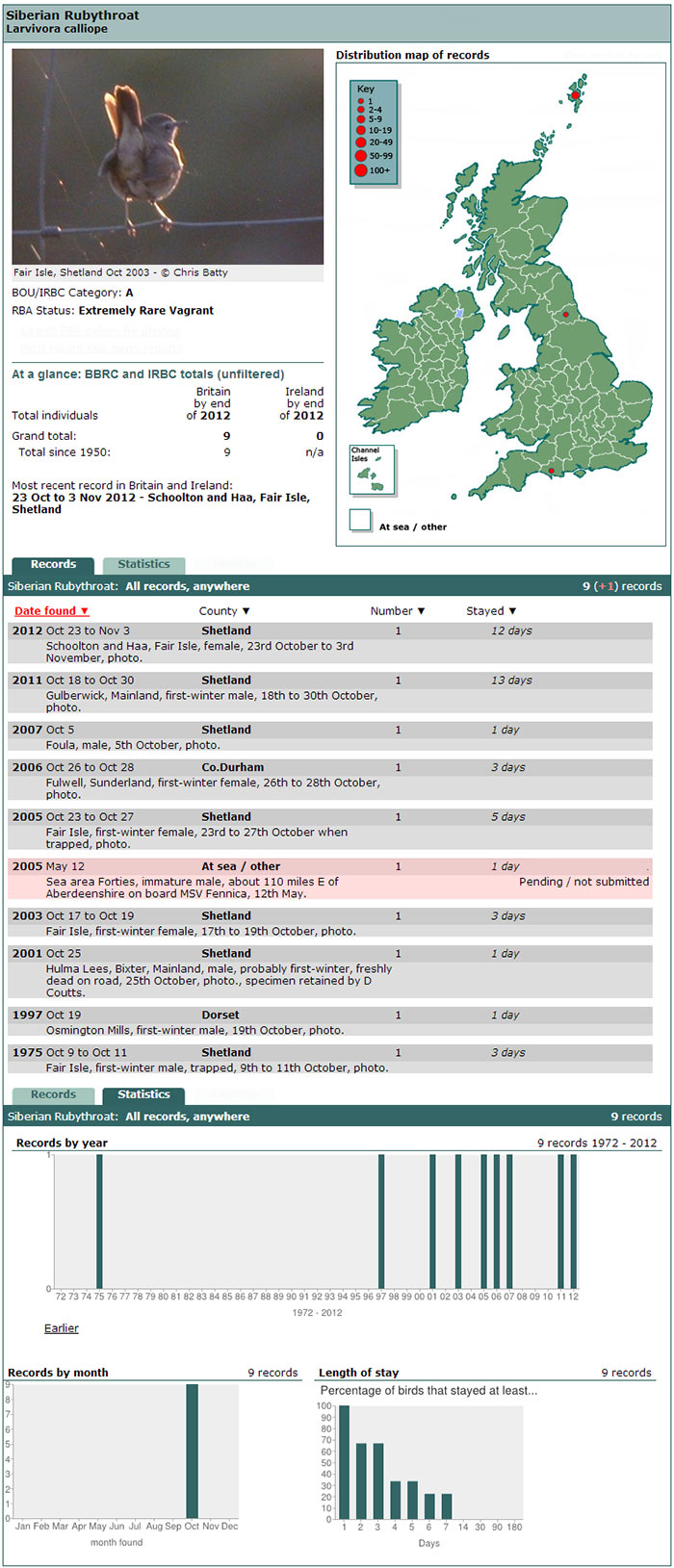
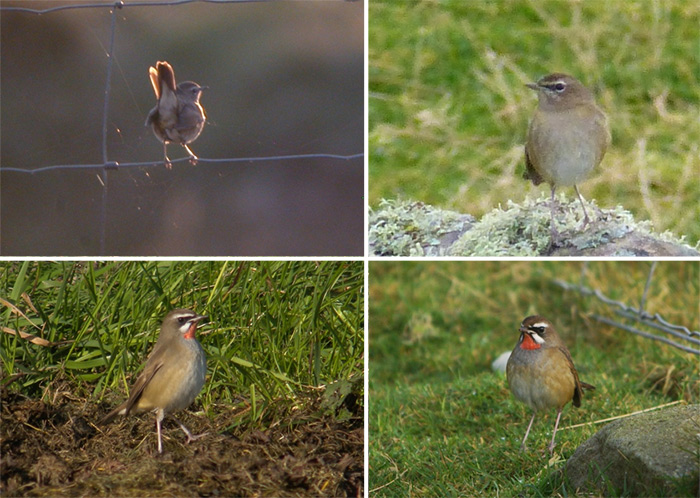
Gulberwick 2011 (© Stuart Piner), Fair Isle 2013 (© Kevin Kelly)
For weekend listers, the early morning news bode well ~ the bird still present in the Levenwick garden on 4th, but as heavy rain set in, so did the misery. No sign through to the middle of the afternoon at least…but as the front cleared, things perked up markedly for all and sundry as the “boy” did the business ~ and continued to do so the following day too (albeit accompanied by a scrum of Eton Wall Game proportions by the sounds of it ~ texts received from some on site mentioned, in no uncertain terms, a certain lack of respect from some birders towards their fellow enthusiasts. It wasn’t couched in such florid terms, but I’m sure you get the drift).
Whether those present on Day 4 and Day 5 (6th-7th) had to put up with such goings-on I don’t know, but they probably wouldn’t give a monkey’s as the bird was still there and “they” were watching it! #getarseingear
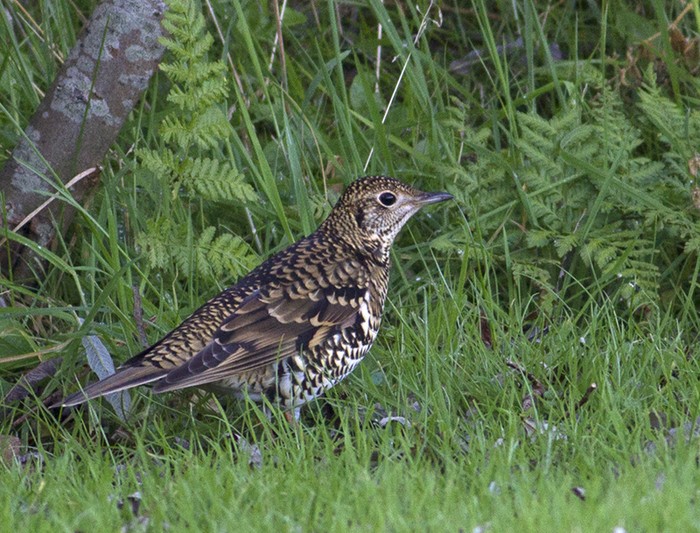
Whilst the Shetland Mainland is still in our minds and before getting lost in a sea of rares, let’s whizz ourselves quickly through another chance to marvel at further images of the outrageously gorgeous, beautiful and bouncy White’s Thrush that gave itself up to all and sundry in the gardens of Durigarth, near Brow Loch until the evening of 1st.
You could write a Thesaurus worth of superlatives and there still wouldn’t be enough to cover this ultimate vagrant’s majesty and delightfulness. So instead of me listing anymore, we’ll just whack up a load more photos which, even for those who’ve seen a few here, are so gripping and so exciting that it’s hard to control one’s self (I’m on four UK gold & black Zootheras to date ~ Copeland Island, St. Agnes and two-in-a-week on Fair Isle ~ and I’m wincing again with envy at how damn fine the Durigarth bird was…without doubt “the definitive views of the species” (as one recent online thread would have described them).
…and, as if by magic, the Friday-typed words regarding Fair Isle’s lovely double-bill in 2008 boded well for an island (currently) bereft of the hot action happening some 40 miles to the north ~ the 4th seeing the arrival of the second Shetland White’s Thrush within a calendar week, this one found at Wester Lowther, becoming the 30th for Shetland and the 14th for Fair Isle in all.
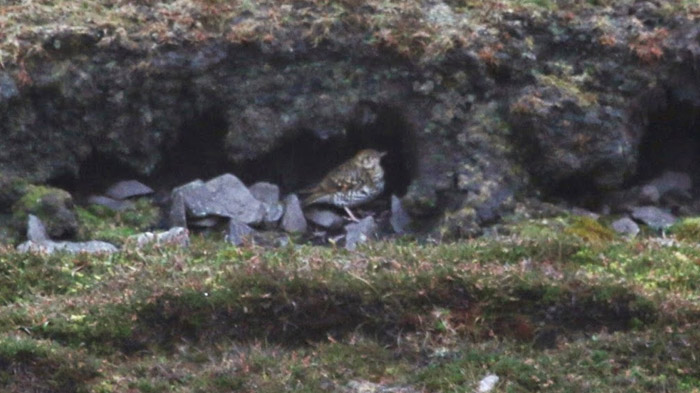
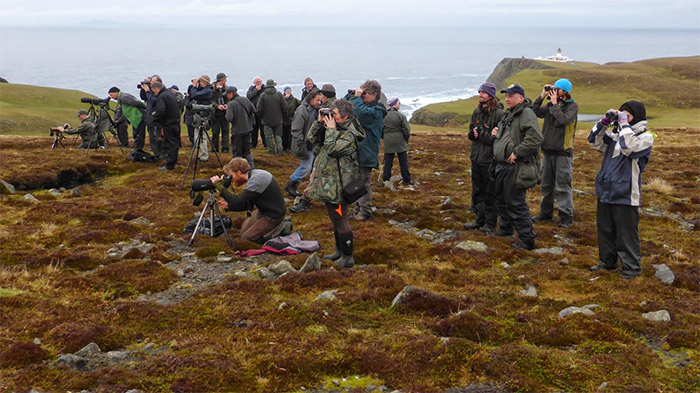
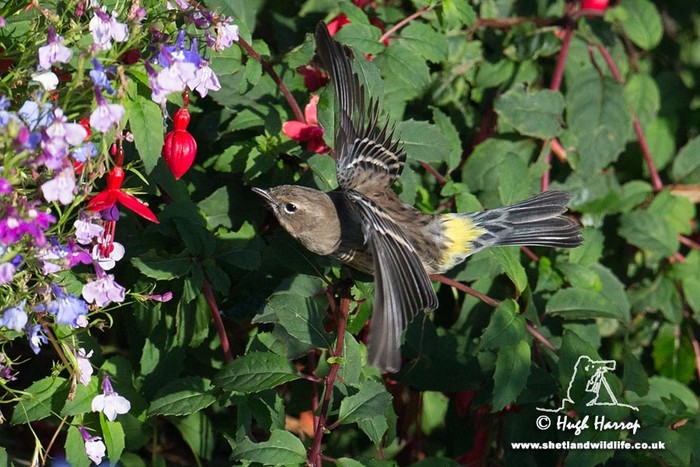
…and quickly, before departing the 15 miles that separate Levenwick and Grutness, the third mega to be logged in that small section of Mainland Shetland was the still present Myrtle Warbler a bird that, like the other-worldly Thrush above, remained in place until 1st in the gardens of one of the most southerly parts of the main island.
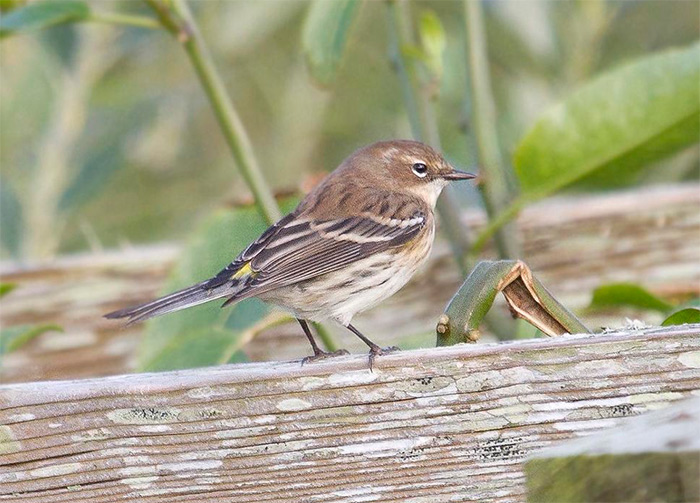
A low-scoring two-day stay at Grutness it may have been, but that didn’t stop the snappers and the more artistic lensmen, and supremely talented solo lenswoman, from capturing some delicious and, in a few instances, very different images of this pleasing, perky wood-warbler.
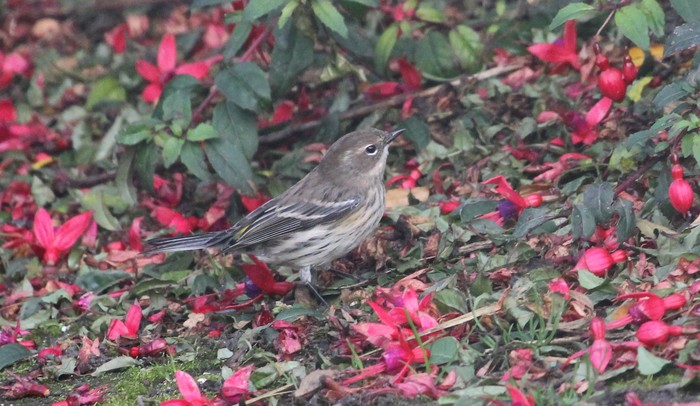
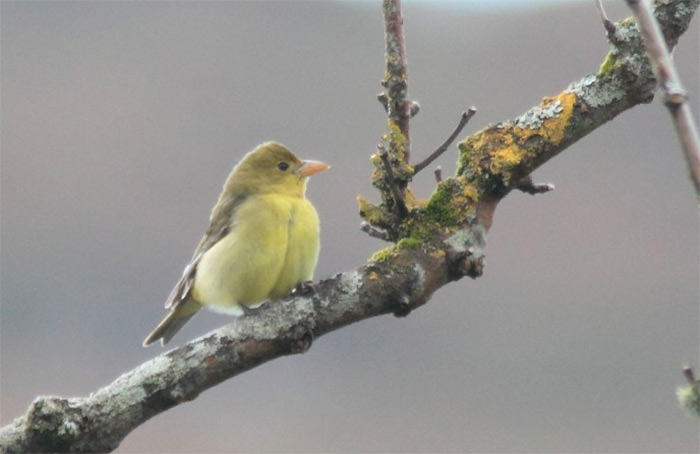
Yes, yes, this is far rarer than either the Mr White’s or Ms. Mrytle and it is actually the rarest bird of the bunch this week but, well, there’s kind of a flow going on with the Shetland shizzle and, let’s face it, from a wholly cosmetic point-of-view in an avian “pretty-off”, bouncy Thrush and stonking Rubythroat are neater things to gawp at than a pesky ole Tanager.
But a Scarlet Tanager is a truly outstanding find and a genuinely thrilling “Mega” to see appear on the pager screen to boot ~ even if the location proved cumbersome for those who’ve yet to connect with this always tough to connect with species.
This week’s bird was found in woodland at Creachan, on Barra in the Outer Hebrides on 6th, becoming a first record not only for the island group but also for Scotland too.
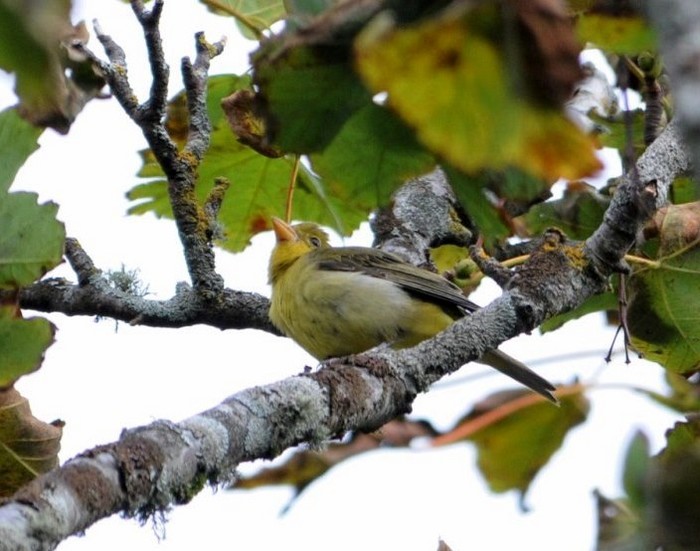
And, for those with the usual time/money resources, the first-winter female lingered to 7th ~ and even managed an online enquiry as to whether the seemingly large-billed bird was actually lurching towards Summer Tanager territory. Some of the photos did little to persuade a few people out there that this was anything other than a second for Britain…others remained sure that it was “just” a Scarlet. Either way, it was a mega!
This superb find becomes the fourth Scarlet Tanager to be seen in the past six years ~ a considerably better strike rate than previous decades ~ those records comprised of a first-winter male at St. Levan on October 20th-21st 2011 which may or may not have been the first-winter male then seen briefly on St. Mary’s on 22nd. Twitchers in Cork for the Little Blue Heron in early October 2008 also had the pleasure of jamming in on the Tanager at Garinish between October 7th-11th.
Prior to that, a 23 year gap stretched back to 1985 came the amazing double occurrence (mentioned here last week) of two birds within six October days at Cork’s Firkeel, with two more logged in the 80’s ~ a seven day female on St. Mary’s in mid-October 1982, along with a photographed one-day first-winter male in the Nanquidno valley in Cornwall in October 1981.
Scilly claimed the only birds of the 1970’s (four in all) with singles on Tresco in 1975 (the only September arrival, appearing two days after the Yellow-bellied Sapsucker) and on St. Mary’s in 1970 ~ a bird that remained, for fifteen years, the first for Britain and Ireland, but which was eventually usurped when a female Tanager sp., trapped on Copeland Island (Co. Down) on October 12th 1963 was finally accepted as a Scarlet in 1985.
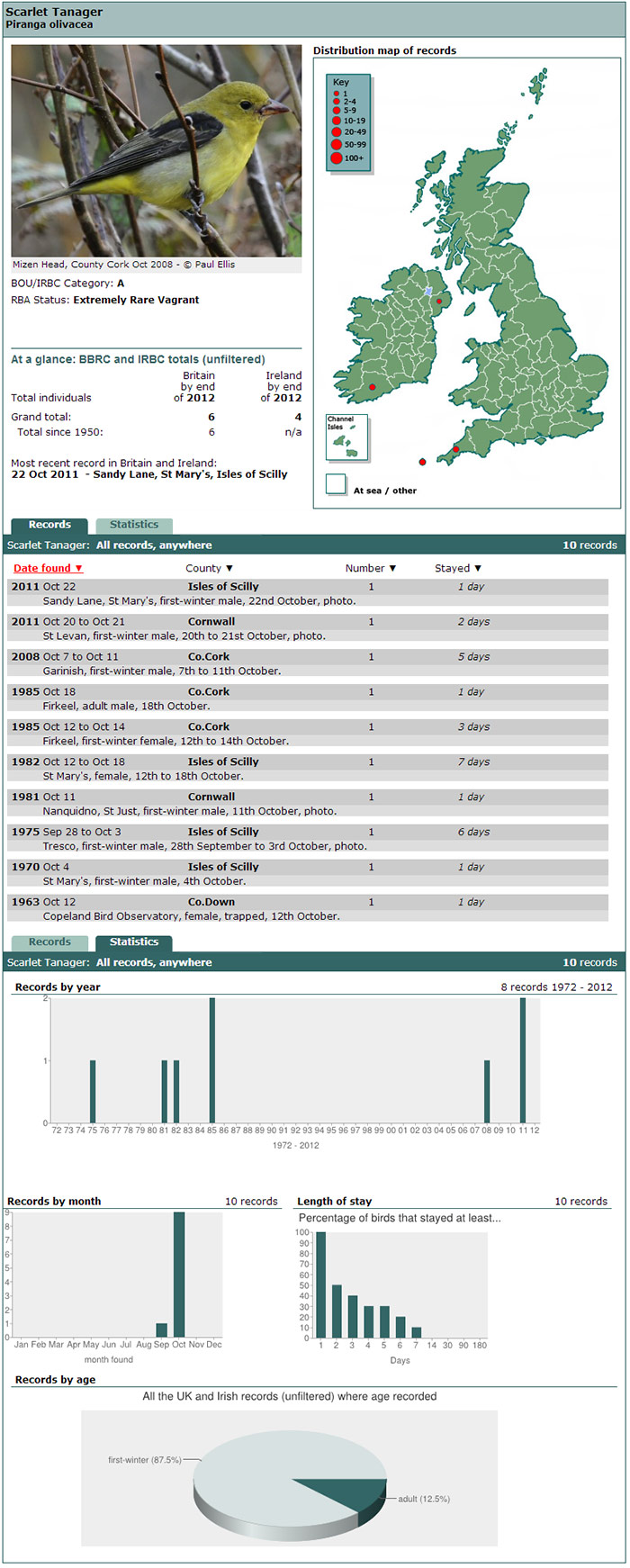
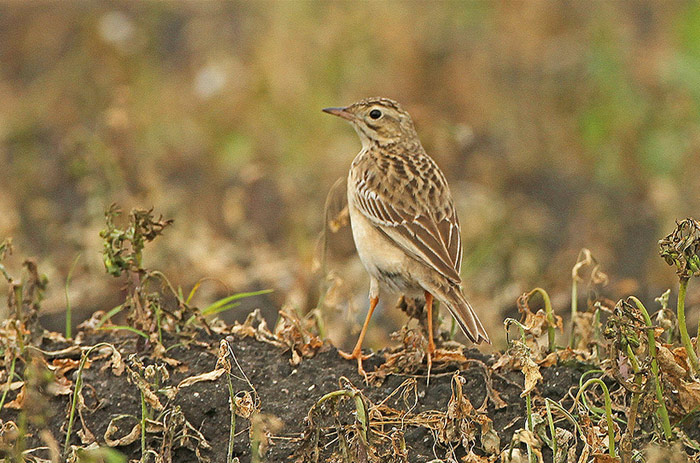
After a suitably familiar period of “is it or isn’t it” questions, a first-winter Blyth’s Pipit was eventually identified in fields adjacent to the airfield on St. Mary’s (Scilly) on 6th, having first been mused upon as perhaps being that particularly tricky species (rather than the rather more common option so familiar to many visitors to the southwestern archipelago) the previous day.
Still a fiendishly rare bird here, there are just 21 accepted records in all and there hasn’t been one in the past seven years ~ when a record four-in-a-year where noted in the autumn of 2007, all seen between October 16th-27th, two of them seen on Shetland, two of them seen in the far southwest, one on the Cornish mainland and one on Scilly (this time on Tresco).
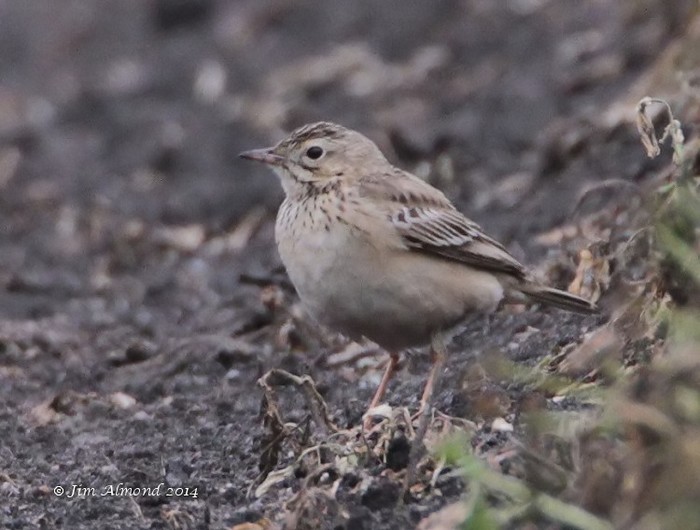
Unsurprisingly, these two island groups are the main locations for Blyth’s Pipit records, Shetland leads with six with four for Scilly (excluding this week’s report), while Cornwall comes next with three birds. On the east coast, Norfolk has two and Suffolk one (all of them popular birds, especially the Landguard bird of November 1994) but these remain the only records on the east coast ~ while stand-out singles include the nine-day Christmas and New Year bird at Gringley Carr (Nottinghamshire) in 2002-’03 and the two-day mid-October individual on Bardsey Island (Gwynedd) in 2005.
The gap between Britain’s first Blyth’s Pipit and Britain’s second was famously loooooooooooooong ~ eminent ornithologist Kenneth Williamson re-identified a skin in the Natural History Museum, Tring, a bird which was collected in Brighton (East Sussex) in October 1882. At the time, the vagrancy potential of the species was thought to be such that it wasn’t accepted on to the British List.
Then, when a Blyth’s Pipit was found in Finland, in 1975, the door was opened and acceptance was approved for the East Sussex individual on to Category B. Then, a full 106 years later, came Britain’s second, an elusive bird found on Fair Isle which was, eventually given the green-light by the Rarities Committee and a further 20 have followed in the intervening 26 years. Despite the upturn in records, it remains a tough call to make (in most instances at least) and that “is it or isn’t it” debate will almost certainly remain on future records too.
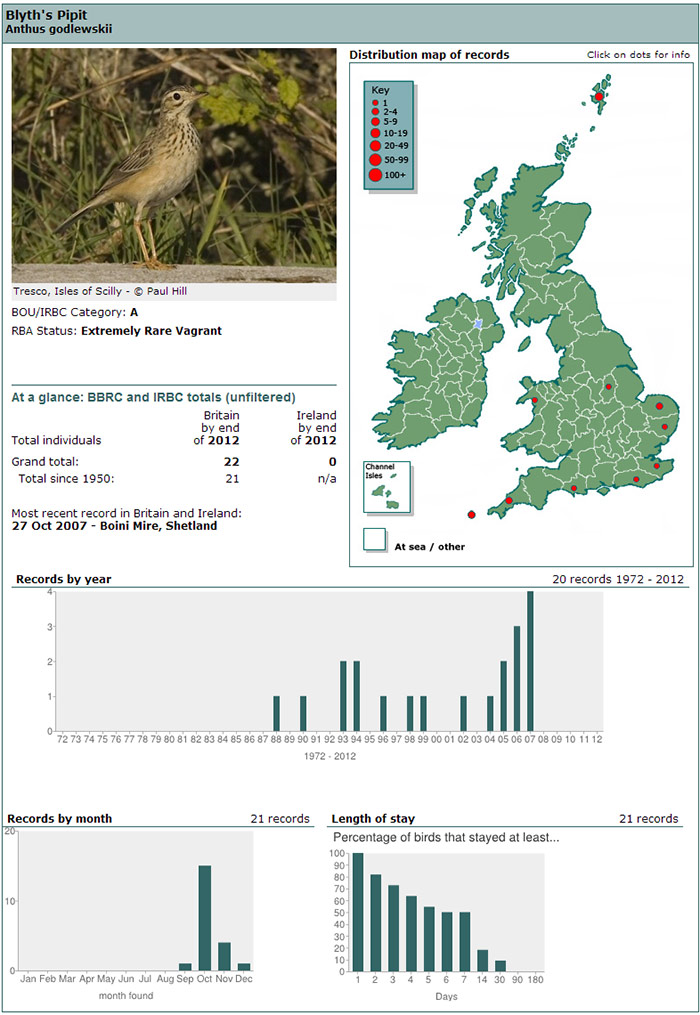
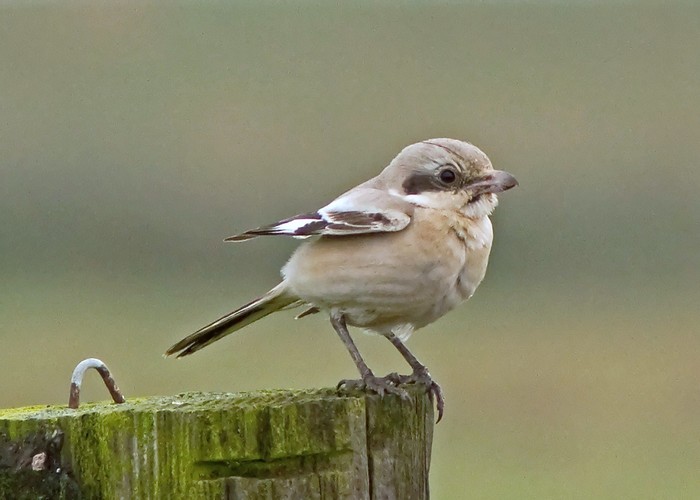
The unseasonally warm weather vibe maintained itself through right up until close of play on Sunday evening, brought to us by the dying southeasterly embers of a fading high pressure that, as we know, was just about to be hoofed unceremoniously out of the way by a big, bad, wet, Atlantic system that was about to scoot across the country.
…and while many were getting rather maudlin at the lack of passerine action on the mainland, particularly on the east coast, the afternoon of 5th produced a species not only predicted here recently but actually hoped for in the county that it actually appeared in ~ yep, Norfolk has finally “unblocked” Steppe Grey Shrike!
Found along the fences and bushes of the main path out from the village of Burnham Norton, this delightful first-winter performed well throughout the rest of the day (albeit a little distantly on occasion) and continued to do so for much of the following day (heavy rain hampering the overall loveliness of the bird on 6th) and the next as well, duly becoming the first county record.
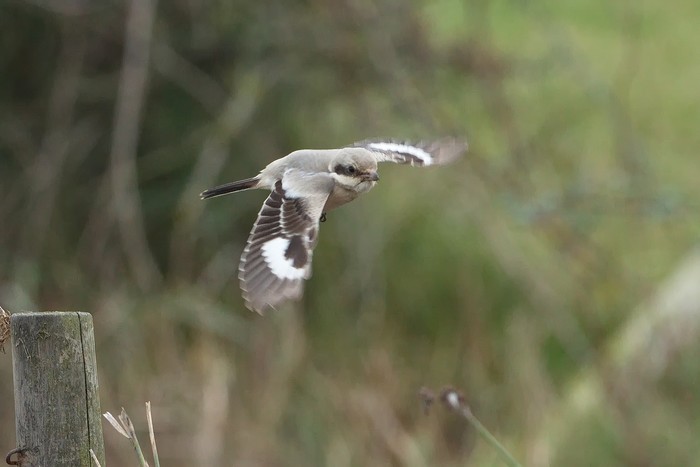
Long overdue in this part of East Anglia, this oft-predicted species has taken an age to reach Norfolk ~ both Lincolnshire to the north and Suffolk to the south have hosted two each in the past but there’s hasn’t been a sniff in between them until now.
This becomes not only a new county bird but also the 25th for Britain and, after the crazy Megas on Shetland and Barra, easily the rarest bird of the week on the British mainland. The first two records of this relatively recent “ new” species were of first-winters trapped and ringed on Fair Isle, in September 1956 and October 1964 but it would another 22 years until the next one (and the first to pique the interest of listers) when one was trapped at Landguard Point on December 6th 1986.
Three autumns later and two Steppe Grey Shrikes were found within 24 hours of each other ~ in Yorkshire, at Bishop Monkton (on October 31st) and in Dorset, at Portland, on November 1st. But still, no one was really twitching them ~ they remained part of the Great Grey group and although a split was mooted, nothing positive was in sight.
A splurge of ten birds were noted through the 1990’s including the only spring record to date (in west Cornwall in April 1992) and five birds in the autumn of 1994 ~ including two Orkney, a third for Shetland and new county birds for Cumbria and Essex. The latter county also hosted the bird that finally saw pallidirostris fall for many ~ a showy bird at Holland-on-Sea for 17 days in November and December 1996 was many people’s first chance at the species-to-be.
The 2000’s have seen a further ten birds recorded, including a “first” for Scilly (on St. Martin’s in the autumn of 2009), a singing male that spent almost a month of the early summer of 2003 on the Isle of Man and very well twitched birds in Lincolnshire (the ludicrously tame bird at Grainthorpe in 2008) and most recently (until now), the 13 day stayer in Shropshire in 2011.
The taxonomy of the grey and black shrikes remains curious ~ pallidirostris is obviously split from the complex excubitor group but remains (for the BOU) firmly within the much-darker and markedly different Southern Grey meridionialis side of things. Surely that’ll change at some point?
Either way, at least one Norfolk lister won’t mind too much ~ this week’s Burnham Norton Steppe Grey Shrike became his 400th county bird.
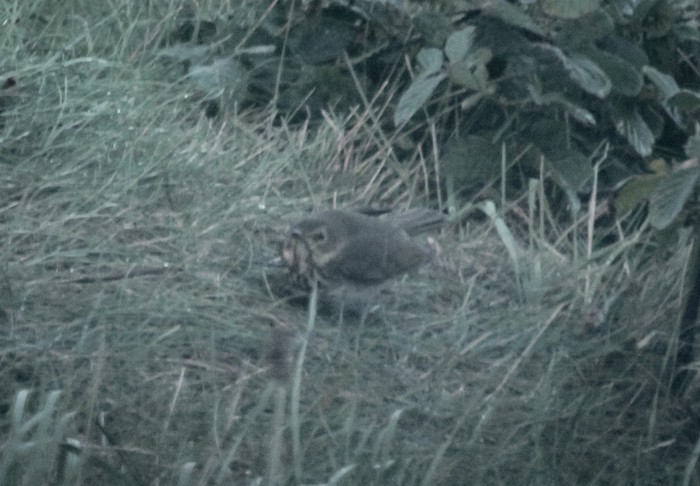
Most of what you’d want to know about Swainson’s Thrush was covered pretty thoroughly within last week’s roundup in relation to Shetland’s 11th record of this often perky-looking Catharus that was found on Unst.
This week brought news of the second of the autumn, the second within a week with Ireland’s County Clare registering a first record for the county, with the location of a Swainson’s Thrush at Loop Head (which has, of course, already hosted a Red-eyed Vireo in the past few days too).
At Loop Head. After a heavy shower and the daylight running out I was leaving the lighthouse area of Loop Head. 7pm a pipit sized bird flew in of the sea, across in front of the car and hit the bank on my right. The bird flew low and direct down the road for some 20 metres landing on the grass to the left. I knew it wasnt a Pipit,slightly to large ,no tail slides and a different flight. What is it?... quick look through the binoculars.It has a smooth Oliveish back no streaks.
What is it?...I knew I was on to something , thought I had an Olive backed Pipit. I snatched around for the camera ..opened the ISO to 3200 because of the lack of light ..I had to get some sort of ID shot. CLICK. The bird flew into a thicket just of the road. I got out of the car ,searched but no luck. What was that? Later on this evening it was confirmed as a rare Swainsons Thrush. A North American species, a 5th Irish record and a 1st for the county." Jeff Copner
Within the 40 or so records of the species, it may seem a little surprising that this becomes only the sixth confirmed Irish occurrence ~ only Mayo and Cork have recorded them before, with the former county’s only record coming on the Blackrock Lighthouse in May 1956, while Cork’s four records include two on Cape Clear Island, in the Octobers of 1968 and 1990 (the Cape also has a record of a Catharus sp., from October 2007), with two more following ~ one at Garinish on October 11th-12th 1999 and at Galley Head on October 11th 2008.
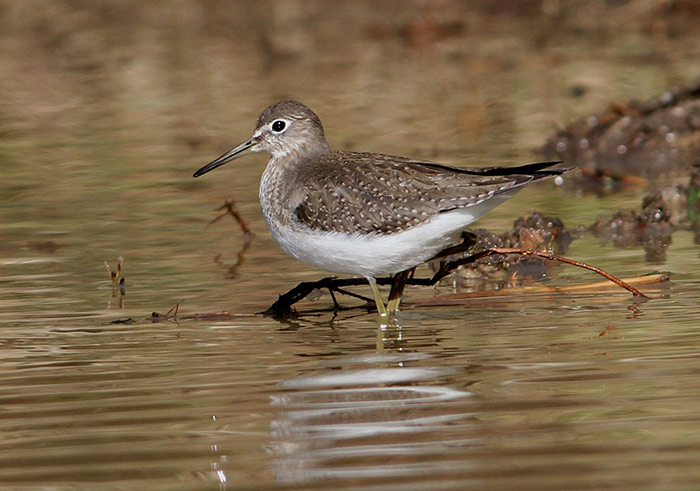
The first Solitary Sandpiper for a couple of years was a super find on farmland around the Duncormick/Rathanganon area of County Wexford on 7th ~ a classic species for the weather system that had just passed from northwest to southeast across the whole of Ireland and Britain.
Sadly, this 1st for Wexford was in an area with no general access, so hopefully the bird hangs on and things can be sorted for all interested parties. This subtle though always pleasing Tringa is an extreme rarity in Ireland, this will be just the six record there, the others coming at Akeragh Lough (Co. Kerry) in September 1968, the Mullet Peninsula (Co. Mayo) in September 2009 and in Cork, at Lissagriffin in September 1971 and Cape Clear Island in September 1974 and, famously, in August 2008 (sharing a puddle with a rather startling companion).
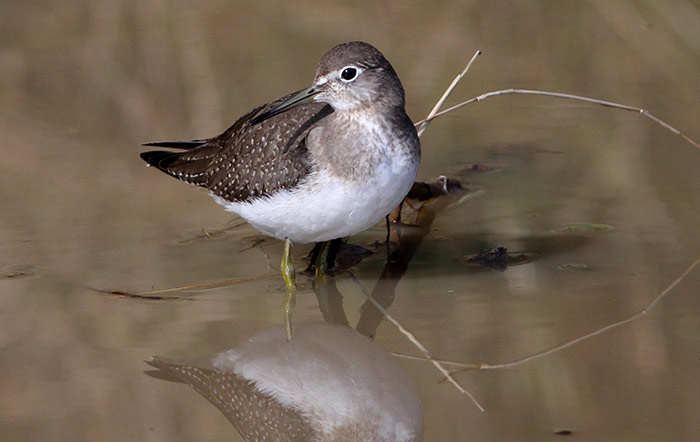
There have been ten records in the last ten years, a decent haul for a species that remains six records short of the half century mark. Scilly remains way ahead of the rest, 14 birds there, including recent “stickers” in 2011 and 2012.
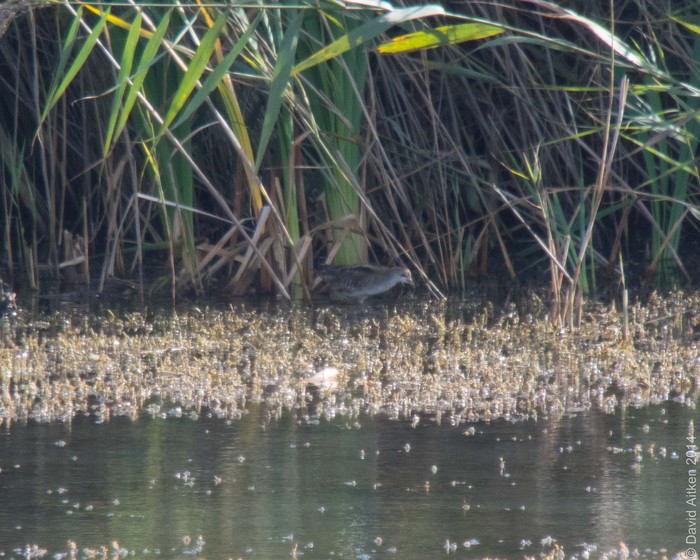
Trying hard to bring a little light relief to mainland birders who didn’t want to do the whole Shetland thing (and therefore be miserable and sullen and generally be all rather grumpy with their collective lots) was the juvenile Little Crake that was finally pinned down at Minsmere RSPB (Suffolk) on 4th.
I say finally pinned down because it started out as one of those “wholly unconfirmed” messages the previous day, but to a sighting relating back to September 30th. Anyway, someone took the bull by the horns, set their sights on trying to confirm this Suffolk mega ~ and duly did so around teatime.
The bird showed off and on through the rest of the evening and on in to the following day too (having been there for nearly a week, it may have been no real surprise but it would have been a huge relief for the local listers) and remained on view, from time to time, to 7th.
This becomes only the third record for the county, the first was shot sometime in 1830 at Oulton while the only record close to the “modern era” was a one-day adult male at Minsmere on September 27th 1973. A county rarity of the highest order indeed…
Minsmere’s second Little Crake is the second of the autumn (the second for September actually) following on from the juvenile present in east Devon, at Seaton at the start of the month and they represent the first records here in over three years.
With all the bleeps and what not from the pager in the past 10 days or so, we mustn’t forget that it was a Shetland Red-eyed Vireo that arguably got this particular rarity ball rolling along when one appeared at Sumburgh on September 25th.
Two more followed on from that one, both in Ireland (one for Clare and then one for Cork) and not long after the shock of yet another Siberian Rubythroat started to sink in, then up popped news of REV #4 for the autumn (and the 4th in nine days) when Ireland delivered their third of the autumn, this one found up in Mayo on Achill Island, near Keen Bay.
There have been six previous Red-eyed Vireos in Mayo ~ the first was found at Belmullet in October 1990 and the remaining five records (prior to this week’s) were all found out on the Mullet Peninsula too ~ all between 2005 and 2008, with three birds found between September 13th and October 11th of the latter year.
East coast Red-eyed Vireos remain a much desired species, with Lincolnshire, Norfolk and Essex still longing for a crack at this portly, though rather suave North American visitor, but one county that added another to their tally was Northumberland, thanks to the “very brief” sighting of one in sycamores at Low-Newton-by-the-Sea on 7th. There has been one record to date in the far northeast, seen for two days on Holy Island on October 5th-6th 1990. Many locals will be hoping the wind dies down and the bird does the bizzo by the time this hits the online airwaves.
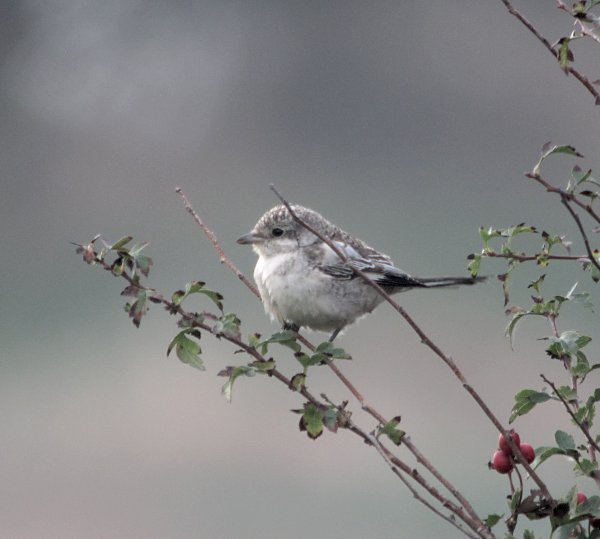
For Masked Shrike to appear so far down the headline acts shouldn’t be seen as any sort of slight on this particular cracker ~ no, no, no ~ it would always struggle to make news within its third week in the Headlines and against Shetland’s East Meets West encounters, there was no chance.
This hugely popular and very well attended third for Britain remained at Kilnsea (East Yorkshire) until October 2nd ~ registering a stay of 13 days in all, just four shy of the Kilrenny first record. A Friday flit is nothing new and who knows, a bird like that could track down (or up the coast) and remerge somewhere completely different. It may seem like a rather unlikely scenario but today’s birding scene is riddled with wacky, weird and wonderful moments…
While the near-glut of Fea’s Petrels seems to remain a constant of most seawatching autumns here, the lack of Barolo Shearwaters has already been mentioned in previous roundups and we’ve now edged up from one to two records for the autumn (compared to over a dozen Fea’s) thanks to this week’s Welsh individual ~ a bird that joins the at-sea record seen well off the coast of Kerry two weeks ago on September 21st.
Whilst there have been a handful of reports of the species from Anglesey in the past, there are just two accepted records to date, concerning a remarkable six birds, all seen in within just a few days in mid-September 1987. The first record was of an astonishing four off South Stack on the 12th, and was followed by two from the same site on 15th and that quartet remain utterly unique.
As the sun rose over the yardarm on a bleary-eyed Wednesday morning, news of a second Barolo Shearwater some eight miles off the coast of County Clare (nearest point to land being Quilty) on the evening of 7th was too rare a species to resist adding in at such late notice ~ the second of the week and third of the autumn could become the 10th or 11th record for Clare ~ all previous records (accepted or otherwise) have come from Bridges of Ross (eight of the nine accepted birds to date have been August birds, while Clare’s first was seen from Bridges on September 30th 1991. Historically, there are just six accepted records for October, the most recent coming from Bardsey on, spookily, October 7th 1988.
What could be one of the last Great Shearwaters of 2014 were logged passing Dursey Island (Co. Cork) on 2nd and Sizewell (Suffolk) on 7th ~ they were the only large shearwaters of the week.
A sometimes stormy week saw up to 14 Sabine’s Gulls recorded across the country, including up to four different birds off Flamborough Head (East Yorkshire) between 2nd-4th, Scottish singles at Lossiemouth (Moray) and in The Minch, off the Rona Bank (on 2nd and 4th respectively), an Irish single off Cork’s Mizen Head on 5th and on 6th, two each for Dungeness (Kent) and Broadford Bay on the Isle of Skye. Further lone birds were recorded in English waters off Hartlepool Headland (Cleveland), Filey (North Yorkshire) and Milford-on-Sea (Hampshire).
Around 25 Long-tailed Skuas were noted from 10 counties countrywide this week, including seven off the coast of East Yorkshire, with four off Flamborough on 2nd being of particular note. Six birds were seen in Highland, including two off the Rona Bank on 4th and two more at Embo on 6th. Six individuals were split between Moray, Lothian and Fife while, further south, counties facing the brisk southeast winds also recorded a handful of Long-taileds, two each for Suffolk and Essex for instance. Singles also found there way to Pembrokeshire and Devon, seen from Strumble Head on 4th and Berry Head on 6th, as well as Hartlepool Headland (Cleveland) on 7th.
Whilst there may not have been a whole heap of Long-tailed Skuas on offer, it was a far better week for storm-blown Pomarine Skuas ~ in the region of 570 recorded with almost half of those being seen in County Mayo, 107 off Annagh Head on 4th the highest count of the week, with 83 off Kilcummin Head on 1st not too far behind. Kilcummin also registered 32 birds on 4th while Annagh’s score for 1st was 14.

At least 74 birds were counted off Hound Point (Lothian) on 6th and 50 were seen from Bridges of Ross (Co. Clare) on 4th. In Devon, 28 Poms flew past Berry Head on 6th with 11 from Splash Point (East Sussex) the same day. A total of 44 birds were seen through the week around the Outer Hebrides and around 35 were seen in East Yorkshire.
The tally of 14 Grey Phalaropes was certainly ably assisted by eight Irish birds ~ one off Bridges of Ross (Co. Clare) on 4th, three off Inishbofin (Co. Galway) and four from Mizen Head (Co. Cork) on 6th ~ while two singles were seen on Scilly and other lone birds were off Fair Isle on 2nd, Ramsey Island (Pembrokeshire) on 4th, at Freiston Shore RSPB (Lincolnshire) on 7th and, for much of the week, still at Morfa Madryn NR (Gwynedd), often showing supremely well.
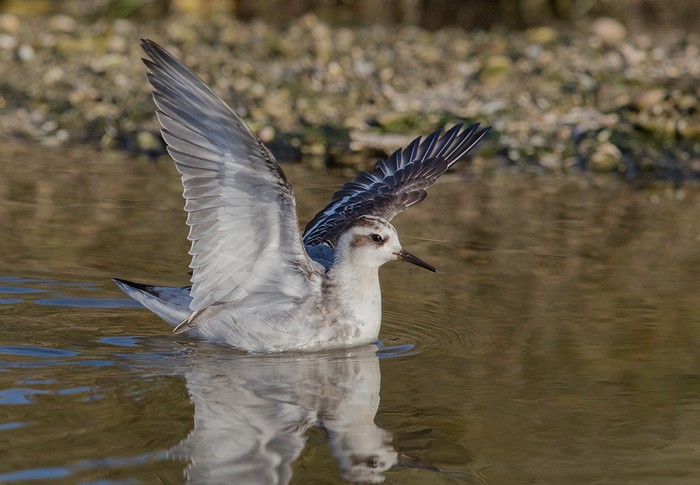
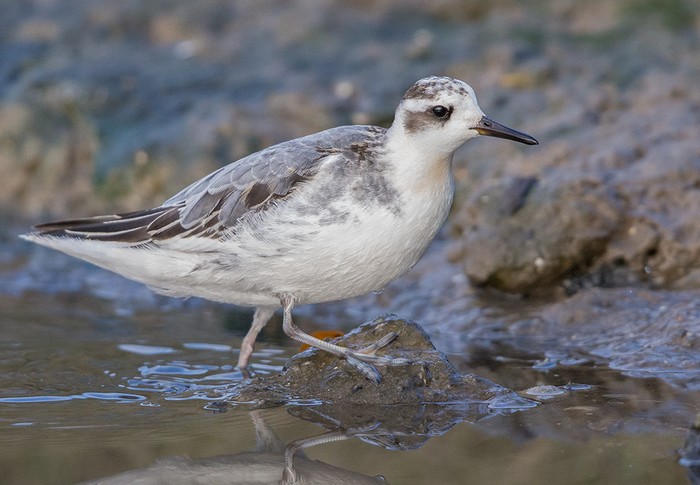
Leach’s Storm-petrels still haven’t had any decent northwest wreck scenarios this autumn so, as a consequence, have been tough to come across. This week saw a slight improvement, around 20 birds noted, with threes for Dorset’s Mudeford Quay (on 6th) and Argyll & Bute’s Hynish, on Tiree on 5th certainly of note. Singles were recorded from Shetland and the Outer Hebrides down to Devon, while six were seen in Ireland (in Mayo, Clare and Galway).
Cornwall and, to a lesser extent Devon, were the heartbeat of Balearic Shearwaters across the past week with some very tidy numbers reported from the far southwest of England. A blustery 3rd saw Porthgwarra’s seawatchers log 204 birds through the day, with a single hour during the mirning of 7th yielding 121. Around the corner and up at Pendeen, 24 Balearics flew past on 2nd with 48 on 4th while 22 were seen at Lamorna Cove on 7th. In Devon, there were 48 off Prawle Point and 28 past Thurlestone on 3rd, while the 6th saw 33 head by Berry Head. Elsewhere, a further 60+ were noted through the week, spread from Scilly and Pembrokeshire through to Northumberland.
Lastly, a Little Auk was reported in Dingle harbour (Co. Kerry) on 6th. Another Muzza per chance?!?!?!
Norfolk’s juvenile Purple Heron reported last week (on 25th) from Sculthorpe Moor NR near Fakenham turned out to be right on the money for once ~ still present on 1st and 2nd, having apparently been on site for a month or so in all.
Also in Norfolk this week, two White Storks around Breydon Water on 5th-6th, individuals that will be from the free-flying mob down the road at Thrigby Hall. Another was reported in Scotland this week, seen briefly on a roof in Lenzie, north of Glasgow on 4th ~ presumably taking a look for Ramesh’s convenience store “Fags, Mags and Bags”….
Lancashire’s juvenile Night Heron moved from Brockholes Nature Reserve LWT to the Bamber Bridge area this week, present at Penwortham on 5th.
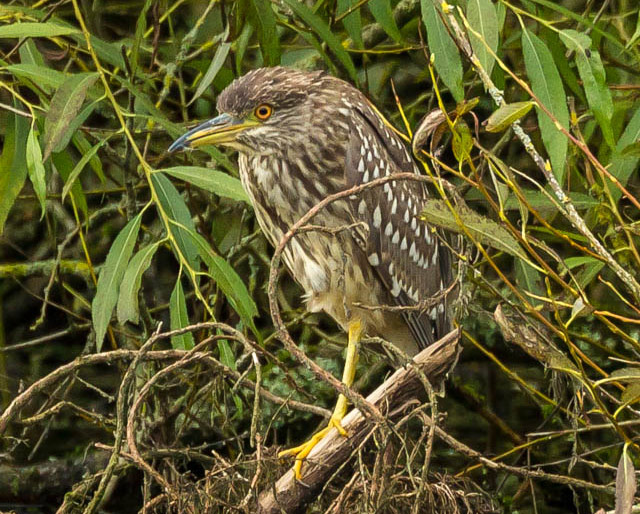
You know the drill now with the next species ~ lingering Glossy Ibis remained at Dungeness RSPB (Kent) to 3rd, Wat Tyler CP (Essex) and Wicken Fen NT (Cambridgeshire) to 4th, Frampton Marsh RSPB (Lincolnshire) to 5th and Tramore Backstrand (Co. Waterford) to 6th. Elsewhere, wanderers roamed through the East Midlands and South Yorkshire, seen at up to three sites in the former county (Blaco Hill and Newington on 4th and reported at Langford Lowfields RSPB the following day) and three sites in the latter too (at Idle Wetlands, Hatfield Moors and Potteric Carr, all on 4th). The final bird of the week was seen at Blacktoft Sands RSPB (East Yorkshire) on 4th.
With autumn well and truly upon us, numbers of Great White Egrets topped the half century for the first time in a good while ~ birds spread far and wide throughout the course of the past seven days, with at least 18 noted from 15 counties on the first day of the new review period.
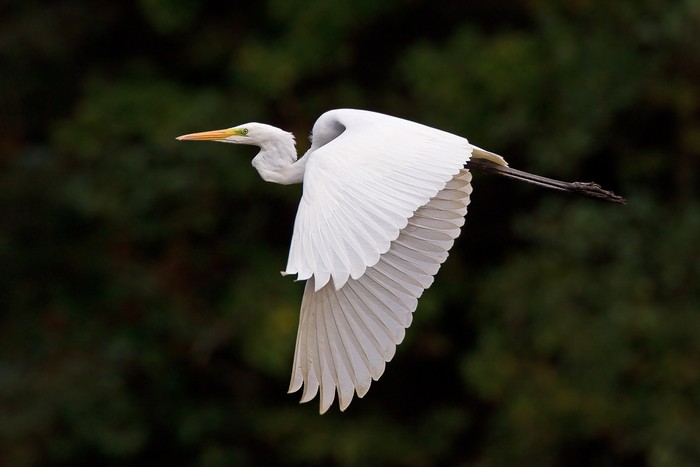
There were no “large” gatherings, just a whole bunch of birds strewn across the place, but there were at least four at Dungeness RSPB (Kent) on 4th, with two more at Pegwell Bay on 7th along with a couple of other singles in the county too. Up to four birds were noted in Lancashire this week, three or four were in Hampshire, there were two twos in Cambridgeshire, a minimum five in Somerset, three or four singles in Wales, numerous loners along assorted east coast counties and inland England counties too.
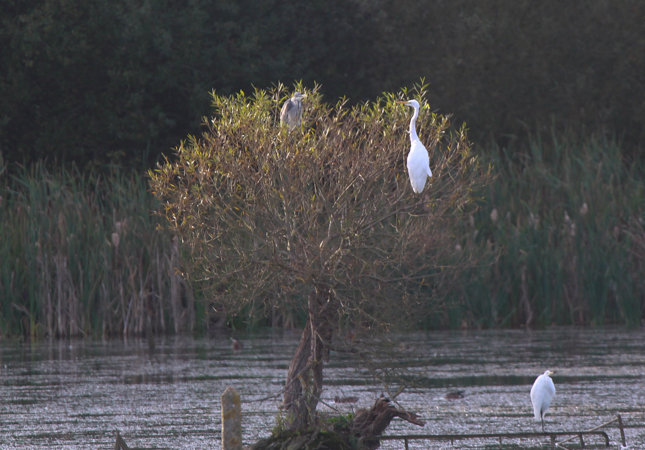
Of particular note were the Great White Egrets seen at Coldstream (Borders) on 5th and also at Sruwaddacon Bay (Co. Mayo) on 3rd ~ I wonder what colour the top of its legs were?
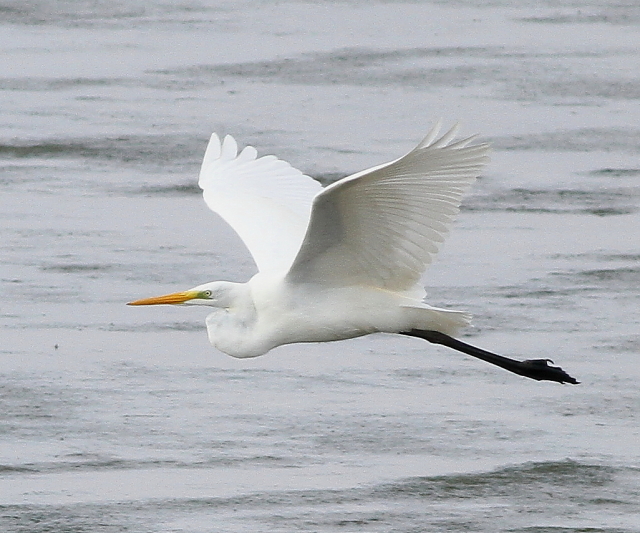
A new Cattle Egret was found at Dungeness RSPB on 1st (presumably having moved from West Sussex) while a second new arrival was found on the border of Ceredigion and Pembrokeshire, on the Teifi Marshes NR on 4th. New bird #3 was at Braunton Burrows (Devon) on 7th. The only other bird noted this week was the lingering bird at Burton Mere Wetlands RSPB reserve (Cheshire), present throughout the week.
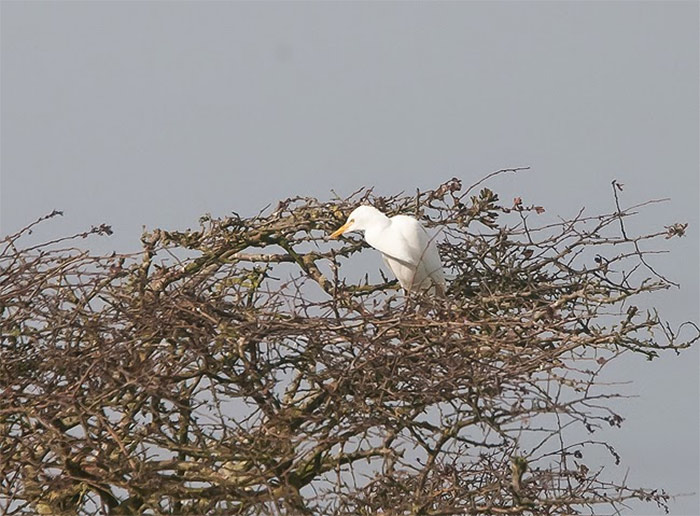
The magic 40 mark was made on 2nd with the Brownsea Island Spoonbills and then boosted further still to an incredible 47 on 5th ~ an staggering total and, comfortably, a modern day record (and in a funny way, one of the most amazing records of the week). That’s a lot of avian cutlery on the go down there…
Numbers elsewhere seem almost irrelevant, but there were six still at the pools at Burnham Overy (Norfolk) on 1st, three headed over Hollan Haven CP (Essex) on 2nd and three were again on the Isley Marsh RSPB reserve in north Devon on 4th. Otherwise it was singles all round for six other counties, from Scilly and Cornwall, to West Sussex and Flintshire to Suffolk and Lincolnshire.
A flock of four Common Cranes flew over Goonhavern (Cornwall) on 1st and were the only birds seen away from “regular” locations. In Yorkshire, the resident first-summer was at Molescroft Carrs on 4th-5th and four were still at Thorne Moors NNR (South Yorkshire) on 5th. In Norfolk, groups of two and four were seen at separate Broadland sites across the weekend, while three were noted on the north coast, at Warham Greens on 2nd with six the following day at Welney WWT.
The only Spotted Crake of a manic week was seen on Unst (Shetland) on 1st. The same island group also hosted one of only two Corncrakes ~ found at Ireland, on Mainland, on 3rd when another was seen and photographed on a seaweed covered rock at Margate (Kent).
A Canada Goose sp., (perhaps an “Atlantic” Canada, of the nominate form canadensis was seen at Loch of Strathbeg RSPB (Aberdeenshire) on September 28th while this week saw a Lesser Canada Goose arrive at Loch Gruinart RSPB on Islay on 4th.
In Highland, a drake Surf Scoter was found on the sea at Embo on 1st and further single males were seen again off the coast of Conwy, in Colwyn Bay and Llandulas on 2nd and again from 4th and also in Largo Bay (Fife) on 5th. In Aberdeenshire, two birds, a drake and a duck were at Blackdog on 3rd while on Shetland, the female King Eider remained at Basta Voe, Yell until 4th.
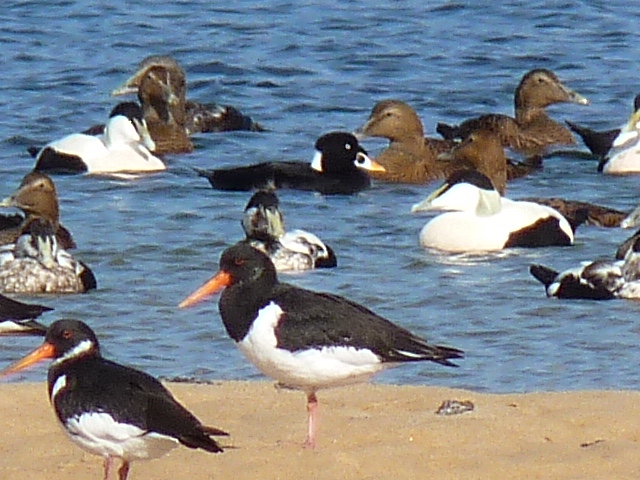
The drake Lesser Scaup remained in Cardiff Bay (Glamorgan) until 5th while on Tiree, a possible juvenile was seen from 1st-6th on Loch a’Phuill. Back in familiar locations were the adult drake Ring-necked Ducks at Ballyshunnock Reservoir (Co. Waterford) on 3rd-5th and St. John’s Loch (Highland) from 4th while in Leicestershire, the drake was still at Rutland Water until 7th.
The female-type Blue-winged Teal (or possible hybrid) remained at Castle Island, near Cambois (Northumberland) to 4th at least while a drake Green-winged Teal was reported from Hampshire on 6th, seen at Old Basing.
Two of last week’s trio of drake American Wigeons lingered in to the early parts of the new review period ~ the bird at North Loch, Sanday (Orkney) present to 2nd and the Irish male, at Inch Island Lake (Co. Donegal) remained to 4th. New was a drake at Bishop Burn (Dumfries & Galloway) on 7th.
A new juvenile Semipalamted Sandpiper was found in the west of Ireland on 2nd ~ seen at Keel, on Mayo’s Achill Island (along with a dead Red-necked Phalarope) ~ it will be the 12th record for the county, a total which included five in the amazing autumn of 2011 (when 64 birds arrived across Ireland and Britain).
Also newly arrived this week was the juvenile White-rumped Sandpiper at Balgarva, South Uist (Outer Hebrides) on 5th while up on Barra, a new American Golden Plover at Eoligarry on the same date was one of five birds found this week. There were two more Scottish island occurrences, on South Roanldsay (Orkney), also on 5th and on the Isle of Skye, at Sconer, on 6th while the 4th of the month saw two new arrivals make landfall in Ireland, at Kinnadoohy (Co. Mayo) and Ring Strand (Co. Cork). The only Buff-breasted Sandpipers reported this week were the still present bird at Drums (Aberdeenshire) to 1st with another reported over North Uist’s Balranald RSPB reserve on 2nd.
Through the 482 accepted records of Lesser Yellowlegs there are very few (just nine) occasions when more than one bird has been noted at one site at the same time. Six of those mini-multiples have been recorded in Ireland and this week we can add a seventh to the list, thanks to the flockette of three on the Rogerstown Estuary (Co. Dublin) on 5th. The first bird arrived on 1st and was seen again on 4th with two more appearing the following day. A fourth new Irish bird was found in Cork, at the Gearagh on 2nd, remaining to 5th).
There has been one previous record of three Lesser Yellowlegs before now, a two and a one seen on Cape Clear Island on August 27th 1991 but these two threes are beaten by a four ~ a quartet seen at Akeragh Lough (Co. Kerry) on August 8th 1973.
Last week saw the review make mention of 17 Pectoral Sandpipers and this week, it is just the same ~ though most of them are different! Half a dozen were seen in Ireland, including two at Tacumshin (Co. Wexford) on 3rd, two singles in Cork and loners also in counties Louth and Roscommon (the latter seen on Annaghmore Turlough, on 5th, the first there for at least a decade.
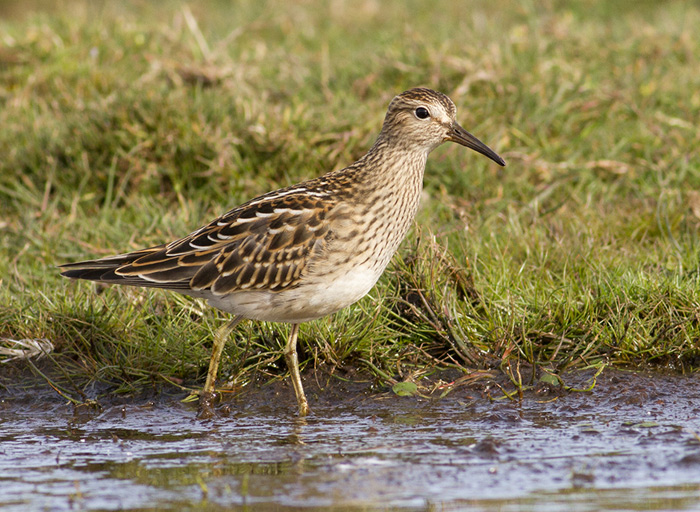
Shetland and Orkney had two birds each (Orkney’s both at Deerness on 4th), and two were noted at Nosterfield (North Yorkshire) on 3rd. The remaining five birds were spread from Cleveland and East Yorkshire, in to Nottinghamshire and then to Dorset and Somerset.
The Temminck’s Stint remained on the pools of Haroldswick, Unst until 1st while Dotterels included one at the Maulin Mountain (Co. Wicklow) from 3rd, at least two on Dale airfield (Pembrokeshire) on 4th, when one was seen over Loop Head (Co. Clare) and also again at Ringstone Edge Reservoir (West Yorkshire). The final birds of the week were seen on Fair Isle on 6th and Tresco (Scilly) and Holy Island (Northumberland) ~ two there ~ on 7th.
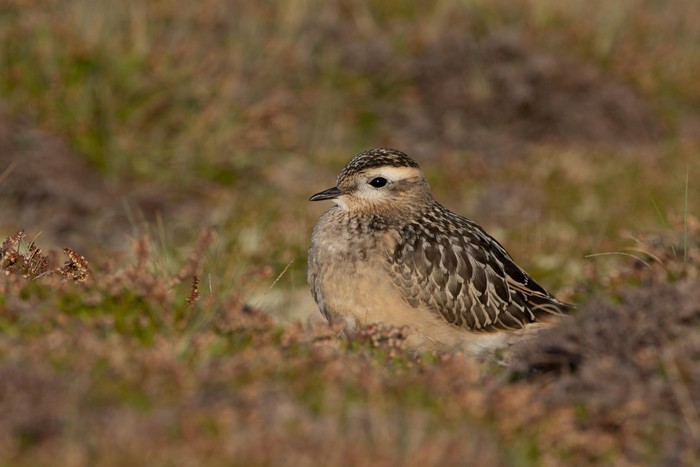
The regular returning adult Ring-billed Gull remained around Dingwall (Highland) for most of the week with Ireland accounting for the other three birds noted ~ adults at Ballycotton (Co. Cork) on 1st-4th, still at Portrush (Co. Antrim) to 5th and on the beach at Cruisetown (Co. Louth) from 5th.
A Glaucous Gull was noted on Islay, at Loch Gorm on 5th while the only gulls of note were some 16 Caspian Gulls which included three at Dungeness during the week, including a red-ringed first-winter on 4th, one of fivecolour-ringed birds noted across the country this week ~ the fourth-winter (potential hybrid) remaining at Amble (Northumberland) to 4th, while green-ringed first-winters from the same colony at Lausitz, Brandenburg, Germany were seen at Upton Warren NR (Worcestershire) on 2nd and Shoreham-by-Sea (West Sussex) on 5th. Another green-ringed bird was in North Yorkshire, at Nosterfield on 7th. Two singles were seen at Cley (Norfolk) during the week and two were noted at Stanwick (Northamptonshire) on 1st.
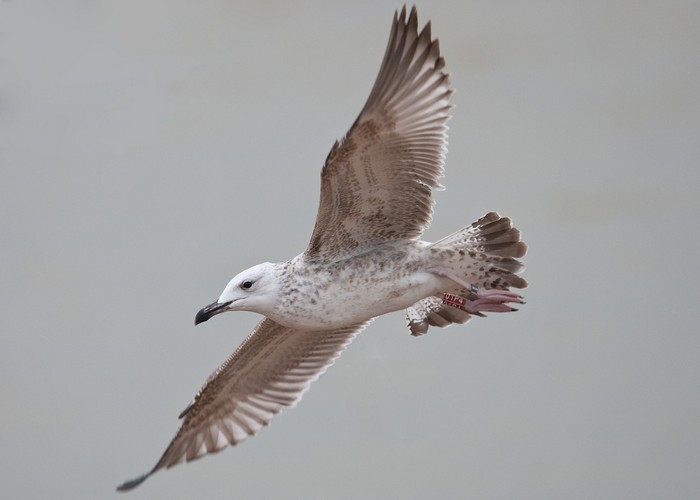
There were two Gyrfalcons noted this week ~ the first, a white Greenland bird, was reported from Rockside, near Loch Gorm, Islay (Argyll & Bute) on 3rd while a far rarer (or at least overlooked maybe?) grey morph was seen at the lighthouse on the Butt of Lewis (Outer Hebrides) on 4th, reappearing later the same afternoon at the north end of Loch Stiapabhat.
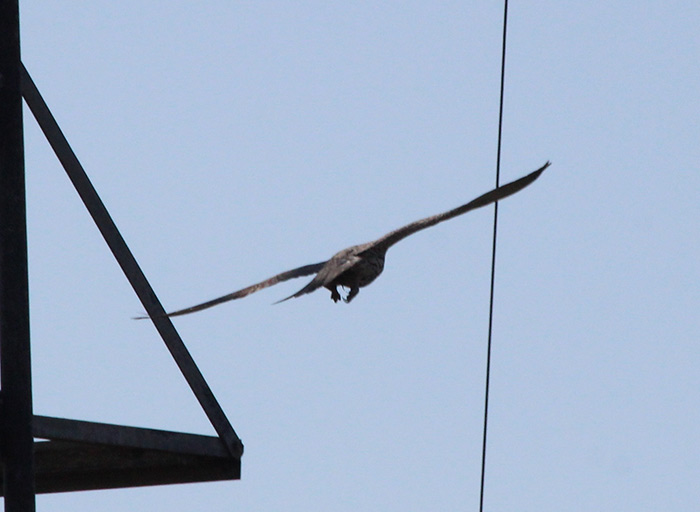
On Shetland, a juvenile Pallid Harrier was watched around the airport at Tingwall on 1st, reappearing there on 4th-5th and another was found on Fetlar on 7th. Also on Shetland, a super Rough-legged Buzzard was photographed over Unst on 3rd. Further reports of the latter species came from Watton (Norfolk) and, remarkably, Totnes (Devon), both on 5th, with a further report in Norfolk, at Stiffkey and Burnham Overy on 7th.
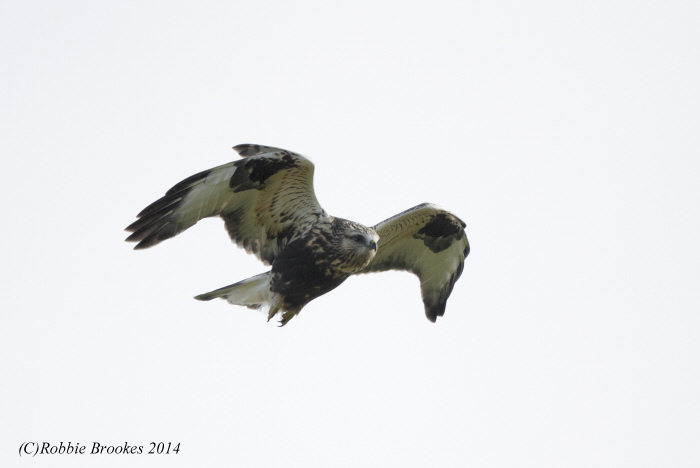
Norfolk hosted two of the week’s three Honey Buzzards seen through the past week ~ singles over Paston on 1st and Blakeney Point on 5th with the final one of the past seven days noted at Pewley Down (Surrey), also on 5th.
A ropey Radde’s Warbler was found near the Sumburgh Hotel on the Shetland Mainland on 6th, where it was released in to a nearby potato field, where it may remain to this moment, decomposing quietly amongst the tatties. Either way, it is the first of the year and the first on Shetland since one at Toab in the autumn of 2010.
Also new on Shetland this week was the Siberian Stonechat that appeared at Skaw, on Whalsay on 6th ~ spending some time in the garden of next week’s correspondent, much to his annoyance as he was in his Lerwick office at the time ~ a small price to pay after clocking up his third male Rubythroat earlier in the week I say…!
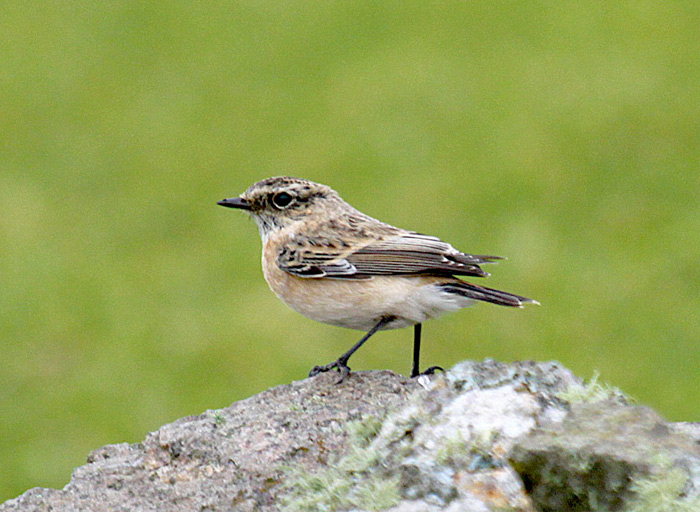
Whalsay also hosted one of the four Shetland Olive-backed Pipits noted across the last week, seen near Skaw on 1st, to be followed by one at Sullom on 3rd and Pool of Virkie and Fair Isle on 7th. Down on Orkney, an Olive-backed Pipit was at Deerness on 1st and then weighing in with a remarkable three was North Ronaldsay, found there on 6th.
The 7th also saw a report of a Pallas’s Grasshopper Warbler around the stream at Quendale on Shetland Mainland ~ photos posted online late in the evening actually showed a Lanceolated Warbler. Not a bad swap…and a bird which, in many, many other weeks would have been elevated into the Headlines ~ but this time around, with so many much rarer birds up for grabs, the demotion was inevitable.
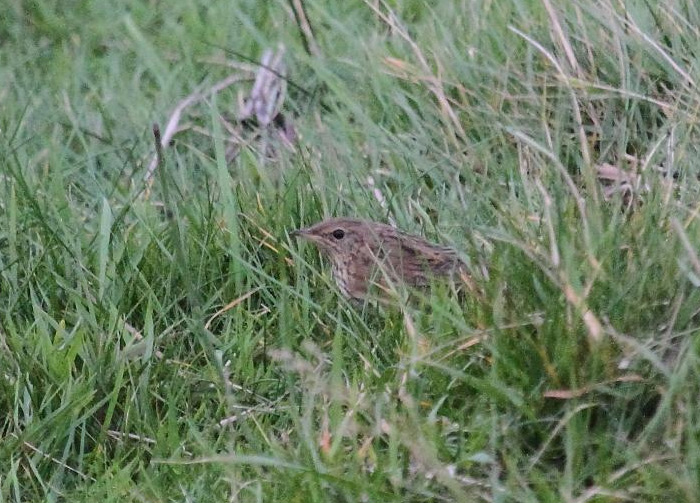
Last, but absolutely not least, the first Pallas’s Warbler of the autumn made landfall at St. Abbs Head (Borders) on 7th ~ the first of many hopefully.
The Baltasound Rustic Bunting continues to break all sorts of records with the prolonged Unst sojourn, clocking up another month on the list since arriving back in August, still present on Shetland to 4th. Nearby, the male Eastern Subalpine Warbler remained to the same date (at least) while on the Mainland, at Veensgarth, the Hornemann’s Arctic Redpoll was present again on 5th-6th.
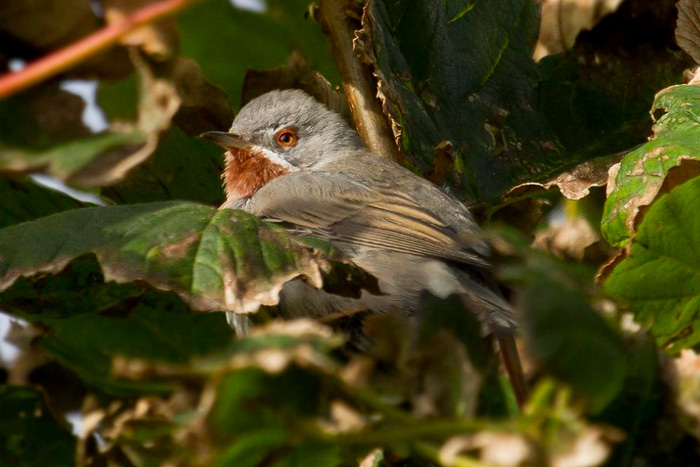
There were three Melodious Warblers up for grabs this week, all in rather out-of-the-way locations. Last week’s bird at Scarinish, Tiree (Argyll & Bute) was re-found on 3rd (following negative news on at the end of last month) while new individuals were logged on Skomer on 2nd-3rd and Out Skerries (Shetland) on 6th ~ only the fourth record in the past four years on the islands (and the latest there since 2007). Elsewhere on Shetland was the only Marsh Warbler of the last seven days, a left-over from the previous week, still at Lund, Unst to 2nd.
Barred Warbler numbers dropped a little again this week, with around 22 logged, with Shetland, once again, topping the pile with eight birds through the week. Scilly and East Yorkshire had two a piece with the popular bird at Blows Down (Bedfordshire) remaining to 3rd. Also of note was the trapped bird on Salisbury Plain (Wiltshire) on 2nd ~ a massive county rare. Singles were doted around coastal localities from Devon to Orkney while Ireland saw County Galway’s off-islands record two singles on 7th, one for Inishmore and one for Inishbofin. The previous day had seen another Barred Warbler arrive at Hook Head (Co. Wexford).
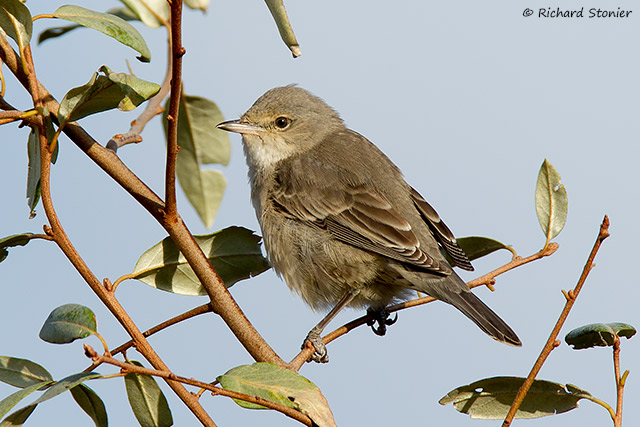
With the shift through the seasons in to “proper” autumn weather this week, the clasic drifter that is Red-breasted Flycatcher saw numbers tail away again to some 13 birds (in stark contrast to that whopping 130+ from a fortnight or so ago). As usual, the totals were dominated by Shetland, six there, including five around the Mainland. Up to three birds were found on St. Mary’s (Scilly) and two were seen around Hartlepool (Cleveland) during the weekend period.
Four of the remaining five RBF’s were further island birds ~ one on Fife’s Isle of May on 5th, one on Cork’s Cape Clear, from 5th-7th and at Lochmaddy, North Uist and Nask, Barra (Outer Hebrides) both on 7th. The mainland exception was found at Collieston (Aberdeenshire) also on 7th.
Wryneck numbers fell away again this week too (no real surprise that), with just half a dozen to report. Two were found in west Cornwall, at Nanjizal on 1st and Botallack on 7th, when one was found next door in Devon, at Dawlish Warren NNR. Staying in the southwest, a Wryneck was on St. Mary’s (Scilly) on 1st when one was found at the end of the East Bank, Cley (Norfolk). Way to the north, the final bird this week lingered at Norwick, on Unst, to 5th.
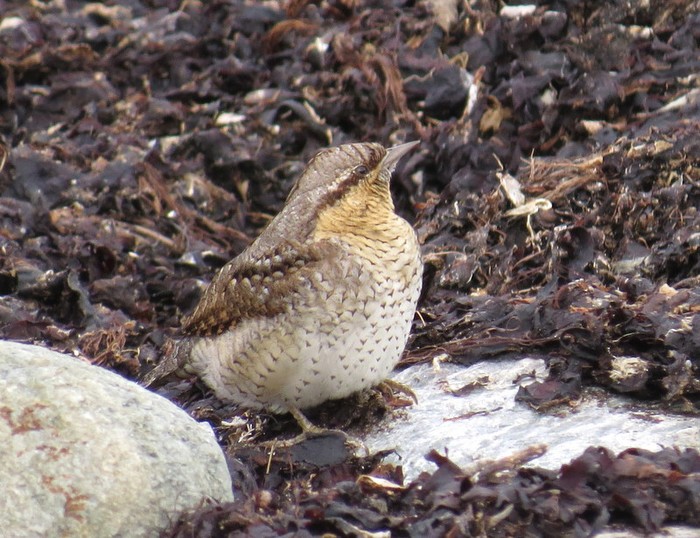
Coming back right at me like some cutesy wing-barred nemesis is the Yellow-browed Warbler ~ a few hundred of which have pushed my instincts for thoroughness to the limits of late ~ it wouldn’t be much of a report that bares witness to “yeah, there were quite few of them again”, so with scrap paper to hand and with no little patience, the tallying process began again as this super little warbler arrived in force once more.
Numbers in the past couple of weeks have gone from 270 to 120 and now back to (amazingly) around 270 again, with Scotland, and especially Shetland making stripy hay while the southeast gales blew.
The nigh-on-impossible task of calculating what’s what reveals around 136 birds on Shetland this week, with the Mainland haul coming in at around 86. Five were noted at Maywick on 1st, six were at Frakkafield on 4th and seven were counted around gardens in Tingwall on 5th. A further five were on Whalsay on 3rd while Bressay scored an impressive 11 on 1st ~ a day which saw a minimum 38 around the islands. A dozen birds (minimum) were counted around Unst, one of nine Shetland islands to register the species this week.
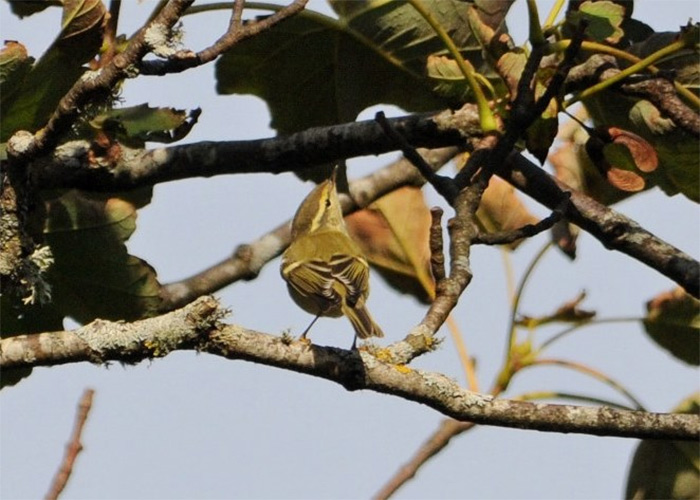
On Orkney, around 16 Yellow-browed Warblers were recorded, including four for Deerness on 1st and up to six through the week on North Ronaldsay. On the Scottish mainland, around eight birds were seen prior to the 7th, when things kicked on somewhat, 20 or more recorded from Borders to Aberdeenshire, with at least eight around the Durness area of Highland (with another three at Balnakiel). Five also appeared on the Outer Hebrides, including three on Barra.
Yellow-broweds across the rest of England, Wales and Ireland managed to add another 87 to the total, with perhaps as many as 42 in the northeast of England which, just like the Scottish east coast, stepped up a gear on the afternoon of 7th, when 25+ appeared including at least 13 around various parts of Holy Island, with another half dozen elsewhere in Northumberland. Thirteen were logged in East Yorkshire too. The southwest registered 18 birds, with up to nine on Scilly and five in Cornwall, while East Anglia’s dozen were split seven for Norfolk, four for Suffolk and one, well inland already, at Paxton Pits NR (Cambridgeshire) on 7th.
In southeast England, six Yellow-browed Warblers were found, including a trapped and ringed bird at a private site in Hungerford (Berkshire) on 2nd. A singleton was seen at Rishton (Lancashire) on 5th and three were found in Wales, in Pembrokeshire, Glamorgan and Gwynedd. Five birds were also noted from Ireland, with two in Galway and singles in Cork, Kerry and Down.
The new review period began with news of the Hoopoe being “still present” on Gwynedd’s Bardsey Island, remaining there to 2nd. The first day of the month also a report of an in-flight only bird over Wallsend (Northumberland) which wasn’t seen again and the final day of the review period brought news of a bird in private gardens at Ballyvocogue (Co. Limerick), which has been around since the end of September.
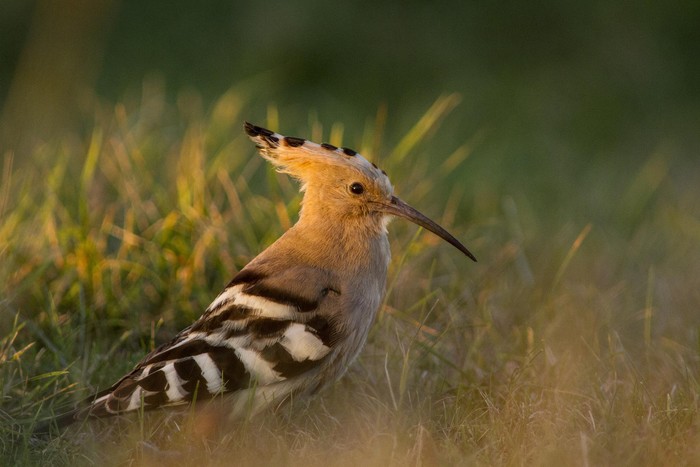
A new bird arrived at Cleggan (Co. Galway) on 3rd and this was followed by a showy newbie at Willington (Bedfordshire) from 5th-7th, the first county record since one was seen at The Lodge, at Sandy in June 2010.
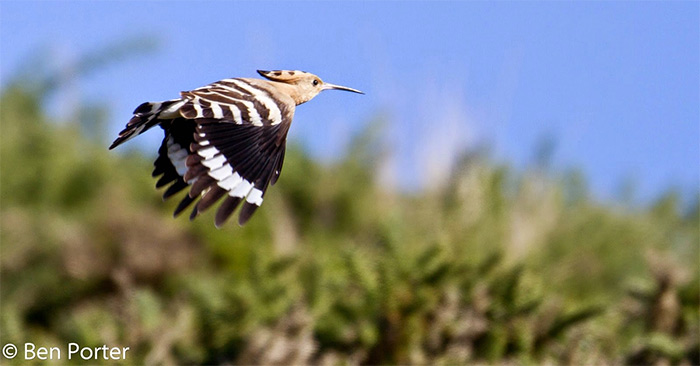
The only Great Grey Shrike for the past seven days appeared on Unst on 7th, seen in flight at Northdale. Seven Red-backed Shrikes were recorded on 1st and included new birds at Otmoor RSPB (Oxfordshire), Stiffkey (Norfolk) and on Sanday (Orkney),while remnants from the last review remained on the Lizard (Cornwall), St. David’s (Pembrokeshire), the Mullet Peninsula (Co. Mayo) and Lowestoft (Suffolk) ~ the latter bird the only one to hang on much further in to the week, present right the way through to 7th.
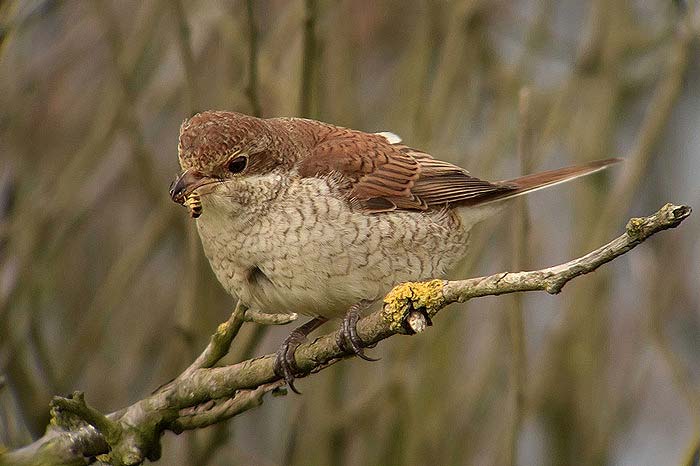
Red-throated Pipits records were typically thin on the ground ~ just the one reported this week, in flight at Spurn (East Yorkshire) on 4th.
There was clean sweep of all the large pipits on the British and Irish list this week thanks to the Tawny Pipit found at Newhaven Tide Mills (East Sussex) on 7th and the Richard’s Pipits found at Polgigga (Cornwall) on 1st, Eswick, Mainland (Shetland) on 2nd, Spurn and Fair Isle on 4th and St. Mary’s (Scilly), Sennen and Cot Valley (Cornwall), Felmingham (Norfolk) and, back in East Yorkshire, at Kilnsea, all on 5th.
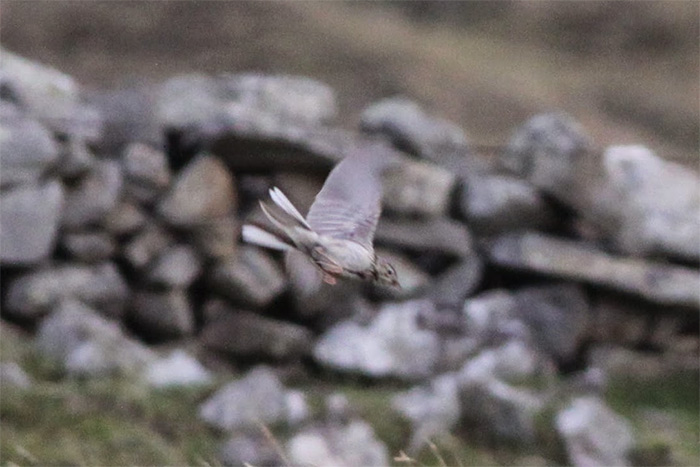
Also on 5th were a couple of Short-toed Larks in the far southwest of England, one present at a private site at Sancreed (Cornwall) and also on St. Agnes (Scilly), both of which stayed put to 7th. New on 6th was a bird on North Ronaldsay while the 7th saw another arrive at Cemlyn Bay (Anglesey) ~ where this remains an extreme rarity ~ just two seen in the past 15 years or more, the only other one being seen in May 2012.
There were six Common Rosefinches noted across the past week, all of them on islands and, just for once, not on Shetland…! First came three singles on 4th, seen on Tiree, at Balemartin and in Pembrokeshire, on Ramsey Island and Skokholm. Off the Irish west coast, one Rosefinch became two on Inishbofin on 5th-6th with the final bird of the week appearing a couple of times on Gugh (Scilly). The sole Serin report was a fly-over at Durlston CP (Dorset) on 7th.
Shetland provided temporary stop-over sites for half a dozen Bluethroats through the week; singles on Mainland where at Tingwall on 3rd-4th, at Toab to 6th (having appeared last week) and at Burrafirth on 7th. Elsewhere, it was one each for Out Skerries (from 1st-4th), Unst (from 1st-2nd) and Fair Isle (from 2nd-4th). North Ronaldsay birders still on a high from the storming male Eye-browed Thrush uncovered a solitary Bluethroat on 1st and the male at Lower Moors, St. Mary’s (Scilly) remained to the same date.
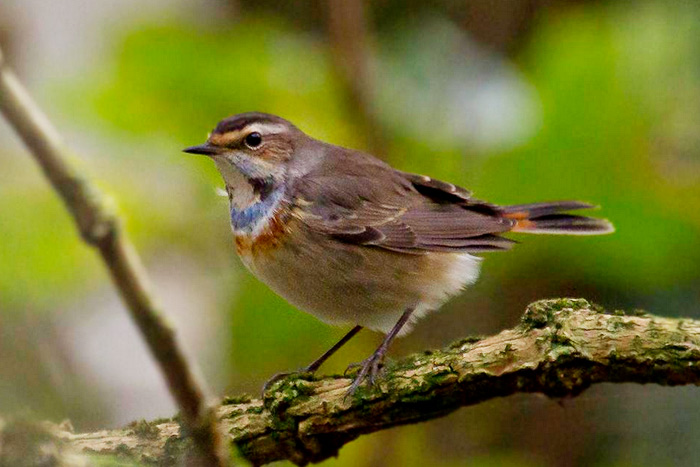
Another autumn week goes by and its another tidy one for the oft-denigrated juvenile Rose-coloured Starling ~ a Lucky Thirteen documented through the past few days, with two for Scilly (stopping on St. Mary’s all week, with another on Bryher on 5th), two on Shetland (one on Fair Isle to 3rd with another at Tingwall on 4th), two for Cornwall (on the Lizard on 4th and at St. Ives from 4th-7th) and two in Cork as well (found on Dursey Island on the last day of last week and still there on 3rd, with a new arrival at Garinish on 7th).
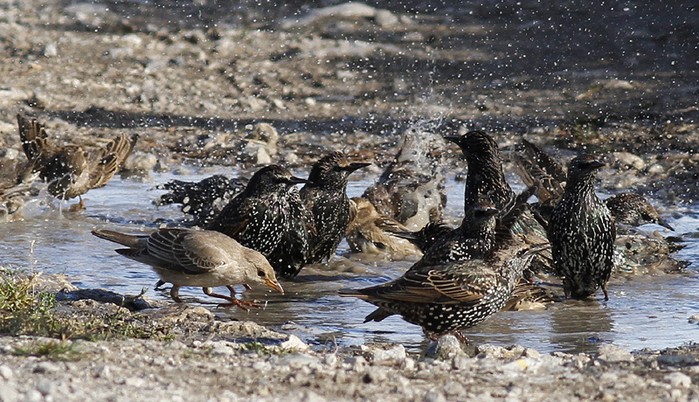
Galway’s Inishbofin welcomed one on 5th and others were seen at Portland from 3rd-7th, Newhaven Tide Mills (East Sussex) on 5th, Birsay (Orkney) on 6th and, best of all (if only for the name of the site…) at the Happy Days Club at Chapel St. Leonard’s (Lincolnshire). The first one to think of an middle aged lothario in a leather jacket, thumbs held aloft going “heeeeeeeeeeey” doesn’t win anything other than a mild hoot of derision….(catchy theme tune tho’ eh?).
A couple of weeks back it seemed as though the Shetland haul of 13 Little Buntings was going to be pretty untouchable this autumn, it seemed a mighty haul for a seven day period. Well, this week, the magic islands have upped the ante as birders located at least 15 birds around the archipelago, including nine on Mainland. First was one at Eswick on 1st and it was followed by individuals at Quendale on 2nd, Boddam and Levenwick on 3rd, Hoswick and Aith on 4th and Wester Quarff, Loch of Spiggie and Sumburgh, all on 6th.
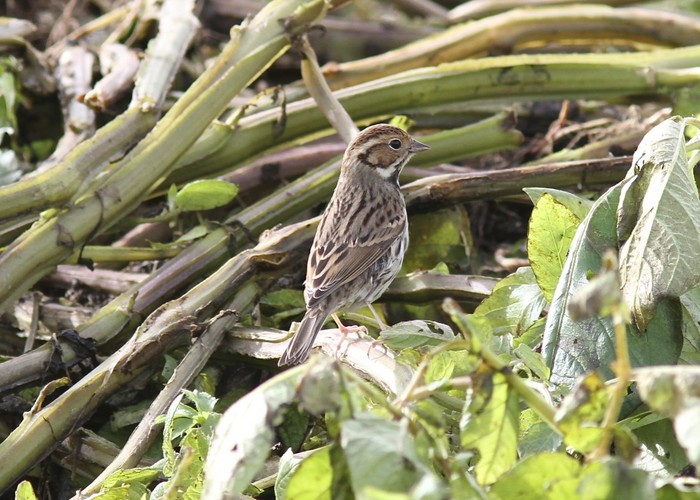
The latter date proved to be a particularly fertile one for the species, two were noted on Fair Isle and there were further new singles on Unst and Out Skerries. The final Shetland bird of the week appeared on Whalsay on 7th.
Little Buntings elsewhere remained as rare as normal ~ singles making it to Bryher (Scilly) on 1st and North Ronaldsay (Orkney) on 6th.
OK ~ so we’re finally done…it is past midnight on Wednesday and I’m in the mood for bed rather than another blether on about what’s on the cards next week. The weather screams great Nearctic birds coming to Ireland and the far southwestern England…I’d love to final crack my prime “bogey bird” (Common Nighthawk) ~ we’re in prime territory for one of those ~ and the crazy thoughts of new birds to Britain or Ireland could run riot ~ Cerulean Warbler, a Yellow-breasted Chat or a new Empidonax to fret over are all whizzing around in my tired mind (if no one else’s…!)
But there’s also a species that has already popped up twice that would certainly draw untold reaction from the online forum dwellers…step forward please Yellow-bellied Sapsucker.
Mention has already been made of the Tresco bird ~ found in trees around the Great Pool on September 26th 1975 where it remained until October 6th. The second record, and the first for Ireland was the marvellous first-winter female found on Cape Clear Island on October 16th 1988, its four day stay giving the hardiest of listers at the time a great chance to make the trip to Cork.

It remains one of my very favourite twitches...leaving Scilly when the news broke on board the Scillonian and then driving from Penzance to Rosslare for the ferry courtesy of Brian “The Leader” Field and his trusty Ford Sierra which, whilst disembarking in Wexford, had a hole torn in to the exhaust ~ we consequently blazed a deafening trail to the west as we scurried to Baltimore for the afternoon boat to the Cape...conversation was as impossible, as sleep was to come to that, given the roar of the car...though the grins as we passed through town after town with locals looking on in amazed horror at the god-awful racket made up for all that...over the sea we went and there it was, sat aside a bush or two, then the conifers in (I think) Cotter’s Garden...SAPSUCKER!
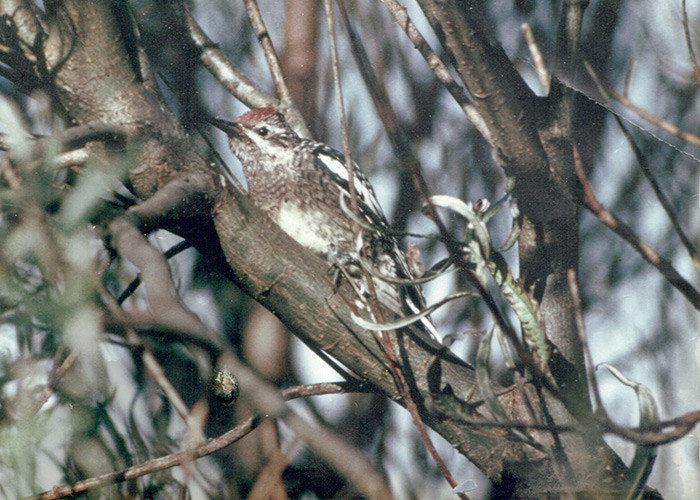
An awesome bird in the autumn sunshine on a beautiful island ~ birding perfection, a monumental twitch and one that reminds me that maybe the old days actually really were the good old days.
Sapsucker is definitely overdue and, for once, its good to have a blocker up the sleeve…
Now though, its bedtime for Bonzo. Jon Dunn is here for next week’s carry on, hopefully he’ll have plenty of crackers to tell you about…
Mark Golley
08 Oct 2014
Many thanks to the rest of our contributors for their photos videos too, we really appreciate your support.
Contributors websites
Check out our contributors website for more great photos and news









